Importance of Ethicality in Business: After Rana Plaza
VerifiedAdded on 2022/12/15
|25
|4700
|232
AI Summary
This study analyzes the importance of ethicality in business by discussing and analyzing the collapse of Rana Plaza from various perspectives. It identifies the unethical practices of the factory owners and international buyers of 'Fast Fashion' and provides suggestions for preventing such incidents in the future.
Contribute Materials
Your contribution can guide someone’s learning journey. Share your
documents today.
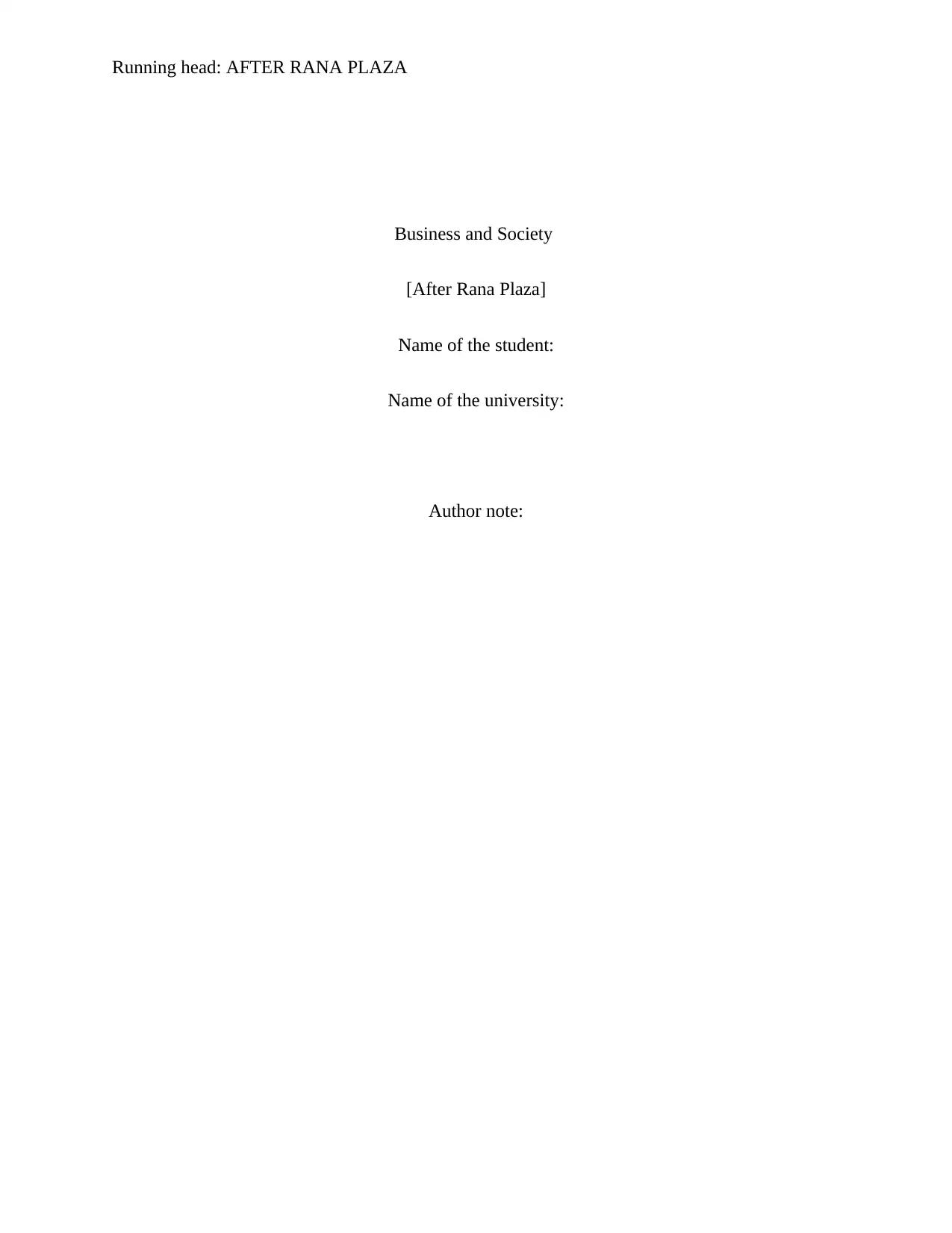
Running head: AFTER RANA PLAZA
Business and Society
[After Rana Plaza]
Name of the student:
Name of the university:
Author note:
Business and Society
[After Rana Plaza]
Name of the student:
Name of the university:
Author note:
Secure Best Marks with AI Grader
Need help grading? Try our AI Grader for instant feedback on your assignments.
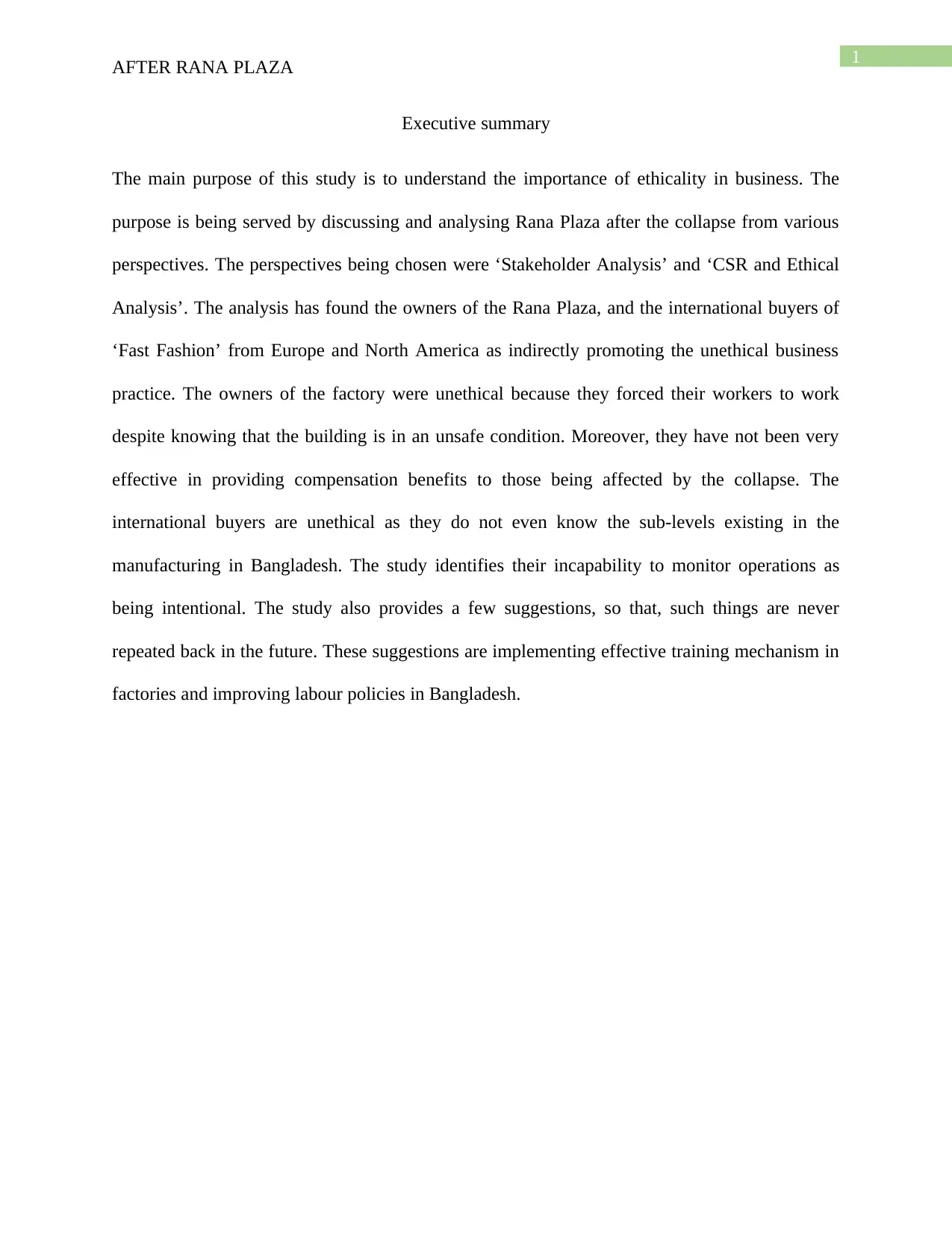
1
AFTER RANA PLAZA
Executive summary
The main purpose of this study is to understand the importance of ethicality in business. The
purpose is being served by discussing and analysing Rana Plaza after the collapse from various
perspectives. The perspectives being chosen were ‘Stakeholder Analysis’ and ‘CSR and Ethical
Analysis’. The analysis has found the owners of the Rana Plaza, and the international buyers of
‘Fast Fashion’ from Europe and North America as indirectly promoting the unethical business
practice. The owners of the factory were unethical because they forced their workers to work
despite knowing that the building is in an unsafe condition. Moreover, they have not been very
effective in providing compensation benefits to those being affected by the collapse. The
international buyers are unethical as they do not even know the sub-levels existing in the
manufacturing in Bangladesh. The study identifies their incapability to monitor operations as
being intentional. The study also provides a few suggestions, so that, such things are never
repeated back in the future. These suggestions are implementing effective training mechanism in
factories and improving labour policies in Bangladesh.
AFTER RANA PLAZA
Executive summary
The main purpose of this study is to understand the importance of ethicality in business. The
purpose is being served by discussing and analysing Rana Plaza after the collapse from various
perspectives. The perspectives being chosen were ‘Stakeholder Analysis’ and ‘CSR and Ethical
Analysis’. The analysis has found the owners of the Rana Plaza, and the international buyers of
‘Fast Fashion’ from Europe and North America as indirectly promoting the unethical business
practice. The owners of the factory were unethical because they forced their workers to work
despite knowing that the building is in an unsafe condition. Moreover, they have not been very
effective in providing compensation benefits to those being affected by the collapse. The
international buyers are unethical as they do not even know the sub-levels existing in the
manufacturing in Bangladesh. The study identifies their incapability to monitor operations as
being intentional. The study also provides a few suggestions, so that, such things are never
repeated back in the future. These suggestions are implementing effective training mechanism in
factories and improving labour policies in Bangladesh.
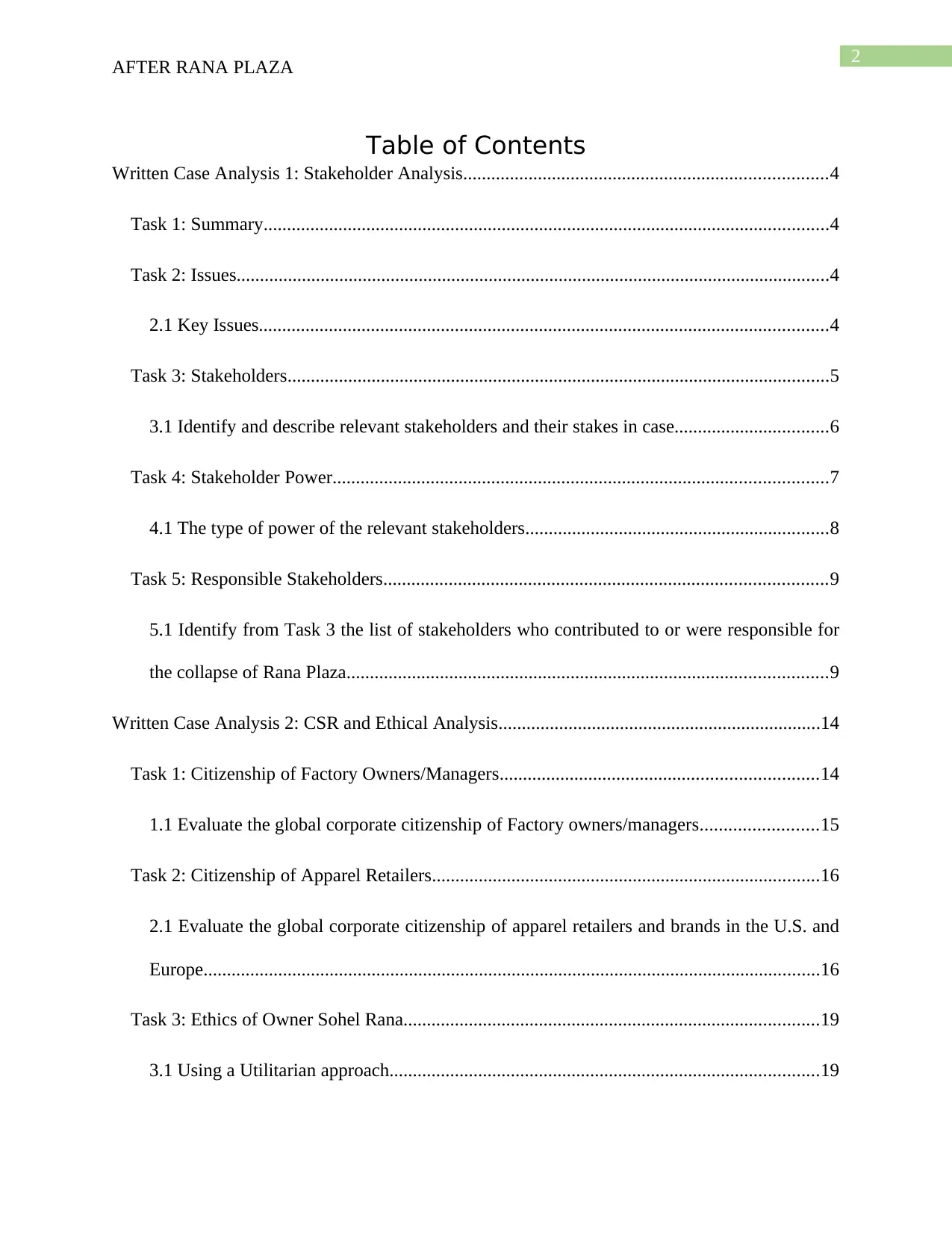
2
AFTER RANA PLAZA
Table of Contents
Written Case Analysis 1: Stakeholder Analysis..............................................................................4
Task 1: Summary.........................................................................................................................4
Task 2: Issues...............................................................................................................................4
2.1 Key Issues..........................................................................................................................4
Task 3: Stakeholders....................................................................................................................5
3.1 Identify and describe relevant stakeholders and their stakes in case.................................6
Task 4: Stakeholder Power..........................................................................................................7
4.1 The type of power of the relevant stakeholders.................................................................8
Task 5: Responsible Stakeholders...............................................................................................9
5.1 Identify from Task 3 the list of stakeholders who contributed to or were responsible for
the collapse of Rana Plaza.......................................................................................................9
Written Case Analysis 2: CSR and Ethical Analysis.....................................................................14
Task 1: Citizenship of Factory Owners/Managers....................................................................14
1.1 Evaluate the global corporate citizenship of Factory owners/managers.........................15
Task 2: Citizenship of Apparel Retailers...................................................................................16
2.1 Evaluate the global corporate citizenship of apparel retailers and brands in the U.S. and
Europe....................................................................................................................................16
Task 3: Ethics of Owner Sohel Rana.........................................................................................19
3.1 Using a Utilitarian approach............................................................................................19
AFTER RANA PLAZA
Table of Contents
Written Case Analysis 1: Stakeholder Analysis..............................................................................4
Task 1: Summary.........................................................................................................................4
Task 2: Issues...............................................................................................................................4
2.1 Key Issues..........................................................................................................................4
Task 3: Stakeholders....................................................................................................................5
3.1 Identify and describe relevant stakeholders and their stakes in case.................................6
Task 4: Stakeholder Power..........................................................................................................7
4.1 The type of power of the relevant stakeholders.................................................................8
Task 5: Responsible Stakeholders...............................................................................................9
5.1 Identify from Task 3 the list of stakeholders who contributed to or were responsible for
the collapse of Rana Plaza.......................................................................................................9
Written Case Analysis 2: CSR and Ethical Analysis.....................................................................14
Task 1: Citizenship of Factory Owners/Managers....................................................................14
1.1 Evaluate the global corporate citizenship of Factory owners/managers.........................15
Task 2: Citizenship of Apparel Retailers...................................................................................16
2.1 Evaluate the global corporate citizenship of apparel retailers and brands in the U.S. and
Europe....................................................................................................................................16
Task 3: Ethics of Owner Sohel Rana.........................................................................................19
3.1 Using a Utilitarian approach............................................................................................19
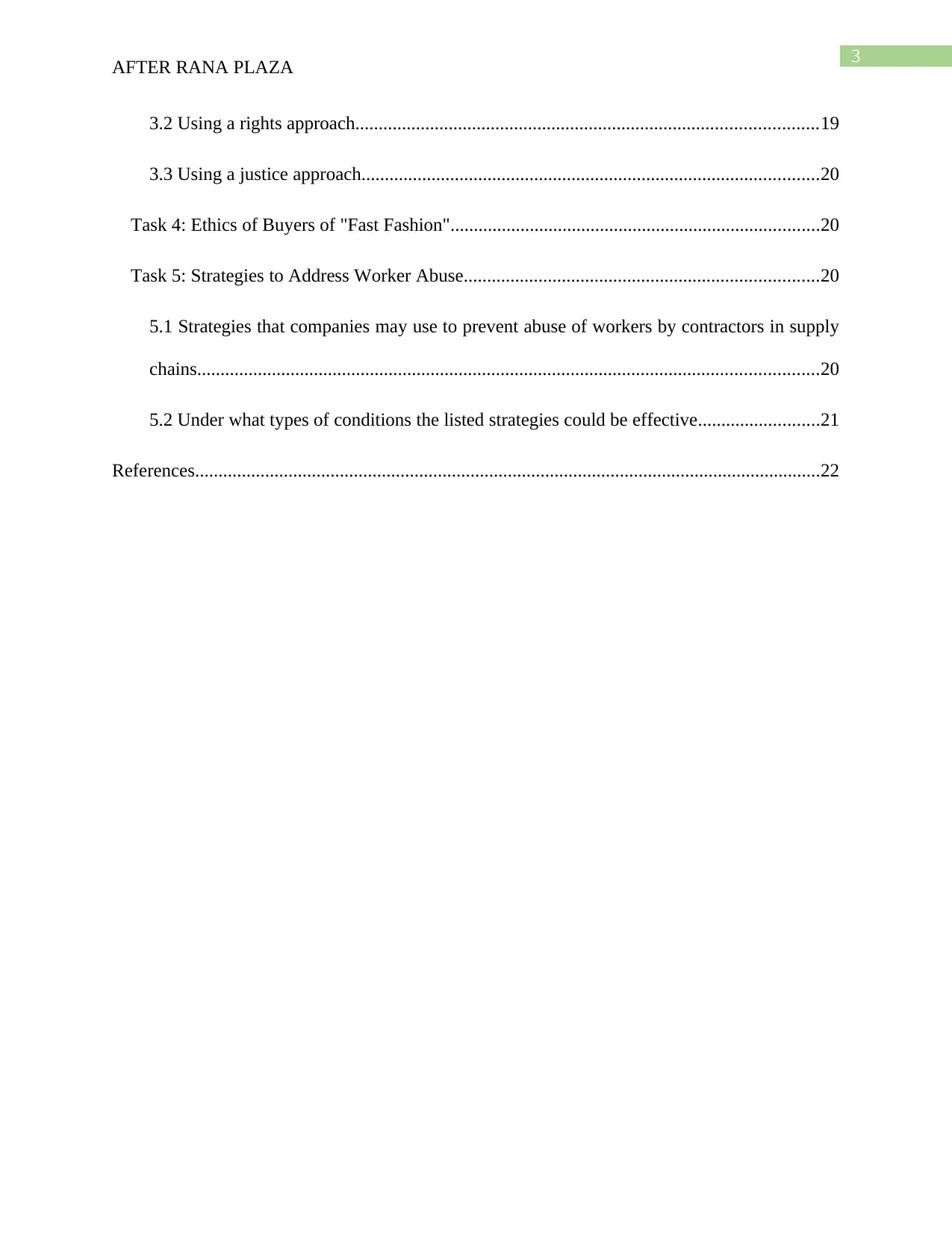
3
AFTER RANA PLAZA
3.2 Using a rights approach...................................................................................................19
3.3 Using a justice approach..................................................................................................20
Task 4: Ethics of Buyers of "Fast Fashion"...............................................................................20
Task 5: Strategies to Address Worker Abuse............................................................................20
5.1 Strategies that companies may use to prevent abuse of workers by contractors in supply
chains.....................................................................................................................................20
5.2 Under what types of conditions the listed strategies could be effective..........................21
References......................................................................................................................................22
AFTER RANA PLAZA
3.2 Using a rights approach...................................................................................................19
3.3 Using a justice approach..................................................................................................20
Task 4: Ethics of Buyers of "Fast Fashion"...............................................................................20
Task 5: Strategies to Address Worker Abuse............................................................................20
5.1 Strategies that companies may use to prevent abuse of workers by contractors in supply
chains.....................................................................................................................................20
5.2 Under what types of conditions the listed strategies could be effective..........................21
References......................................................................................................................................22
Secure Best Marks with AI Grader
Need help grading? Try our AI Grader for instant feedback on your assignments.
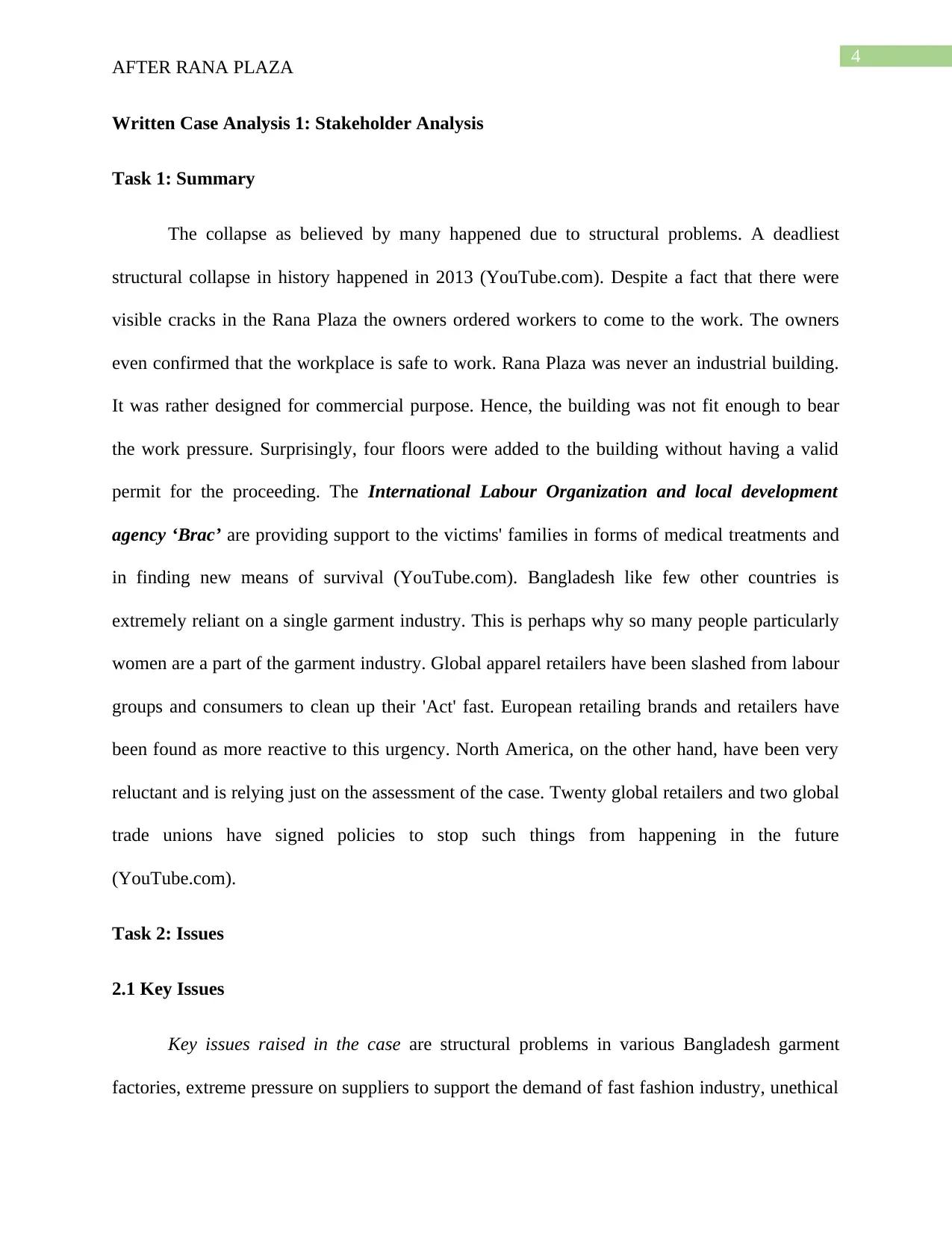
4
AFTER RANA PLAZA
Written Case Analysis 1: Stakeholder Analysis
Task 1: Summary
The collapse as believed by many happened due to structural problems. A deadliest
structural collapse in history happened in 2013 (YouTube.com). Despite a fact that there were
visible cracks in the Rana Plaza the owners ordered workers to come to the work. The owners
even confirmed that the workplace is safe to work. Rana Plaza was never an industrial building.
It was rather designed for commercial purpose. Hence, the building was not fit enough to bear
the work pressure. Surprisingly, four floors were added to the building without having a valid
permit for the proceeding. The International Labour Organization and local development
agency ‘Brac’ are providing support to the victims' families in forms of medical treatments and
in finding new means of survival (YouTube.com). Bangladesh like few other countries is
extremely reliant on a single garment industry. This is perhaps why so many people particularly
women are a part of the garment industry. Global apparel retailers have been slashed from labour
groups and consumers to clean up their 'Act' fast. European retailing brands and retailers have
been found as more reactive to this urgency. North America, on the other hand, have been very
reluctant and is relying just on the assessment of the case. Twenty global retailers and two global
trade unions have signed policies to stop such things from happening in the future
(YouTube.com).
Task 2: Issues
2.1 Key Issues
Key issues raised in the case are structural problems in various Bangladesh garment
factories, extreme pressure on suppliers to support the demand of fast fashion industry, unethical
AFTER RANA PLAZA
Written Case Analysis 1: Stakeholder Analysis
Task 1: Summary
The collapse as believed by many happened due to structural problems. A deadliest
structural collapse in history happened in 2013 (YouTube.com). Despite a fact that there were
visible cracks in the Rana Plaza the owners ordered workers to come to the work. The owners
even confirmed that the workplace is safe to work. Rana Plaza was never an industrial building.
It was rather designed for commercial purpose. Hence, the building was not fit enough to bear
the work pressure. Surprisingly, four floors were added to the building without having a valid
permit for the proceeding. The International Labour Organization and local development
agency ‘Brac’ are providing support to the victims' families in forms of medical treatments and
in finding new means of survival (YouTube.com). Bangladesh like few other countries is
extremely reliant on a single garment industry. This is perhaps why so many people particularly
women are a part of the garment industry. Global apparel retailers have been slashed from labour
groups and consumers to clean up their 'Act' fast. European retailing brands and retailers have
been found as more reactive to this urgency. North America, on the other hand, have been very
reluctant and is relying just on the assessment of the case. Twenty global retailers and two global
trade unions have signed policies to stop such things from happening in the future
(YouTube.com).
Task 2: Issues
2.1 Key Issues
Key issues raised in the case are structural problems in various Bangladesh garment
factories, extreme pressure on suppliers to support the demand of fast fashion industry, unethical
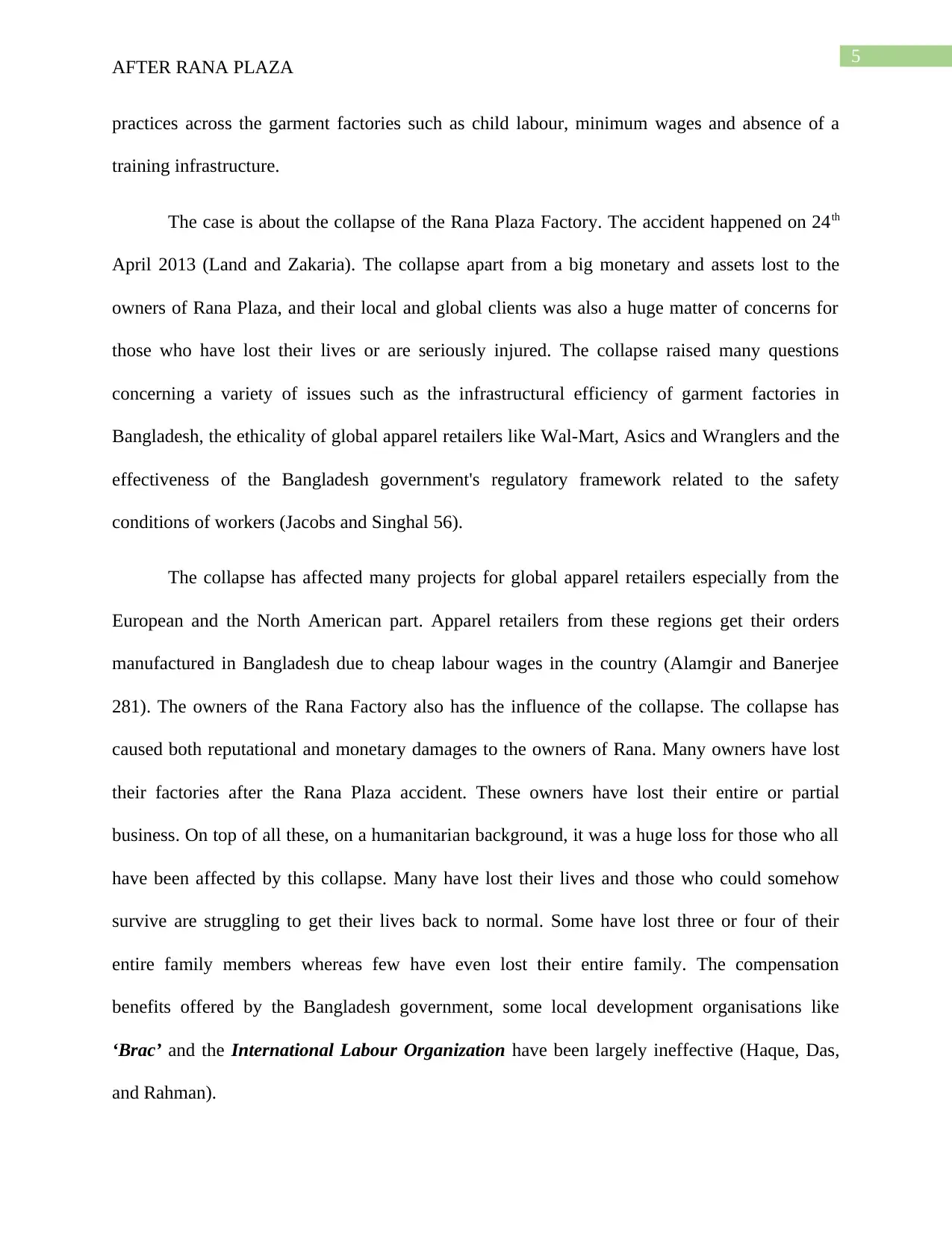
5
AFTER RANA PLAZA
practices across the garment factories such as child labour, minimum wages and absence of a
training infrastructure.
The case is about the collapse of the Rana Plaza Factory. The accident happened on 24th
April 2013 (Land and Zakaria). The collapse apart from a big monetary and assets lost to the
owners of Rana Plaza, and their local and global clients was also a huge matter of concerns for
those who have lost their lives or are seriously injured. The collapse raised many questions
concerning a variety of issues such as the infrastructural efficiency of garment factories in
Bangladesh, the ethicality of global apparel retailers like Wal-Mart, Asics and Wranglers and the
effectiveness of the Bangladesh government's regulatory framework related to the safety
conditions of workers (Jacobs and Singhal 56).
The collapse has affected many projects for global apparel retailers especially from the
European and the North American part. Apparel retailers from these regions get their orders
manufactured in Bangladesh due to cheap labour wages in the country (Alamgir and Banerjee
281). The owners of the Rana Factory also has the influence of the collapse. The collapse has
caused both reputational and monetary damages to the owners of Rana. Many owners have lost
their factories after the Rana Plaza accident. These owners have lost their entire or partial
business. On top of all these, on a humanitarian background, it was a huge loss for those who all
have been affected by this collapse. Many have lost their lives and those who could somehow
survive are struggling to get their lives back to normal. Some have lost three or four of their
entire family members whereas few have even lost their entire family. The compensation
benefits offered by the Bangladesh government, some local development organisations like
‘Brac’ and the International Labour Organization have been largely ineffective (Haque, Das,
and Rahman).
AFTER RANA PLAZA
practices across the garment factories such as child labour, minimum wages and absence of a
training infrastructure.
The case is about the collapse of the Rana Plaza Factory. The accident happened on 24th
April 2013 (Land and Zakaria). The collapse apart from a big monetary and assets lost to the
owners of Rana Plaza, and their local and global clients was also a huge matter of concerns for
those who have lost their lives or are seriously injured. The collapse raised many questions
concerning a variety of issues such as the infrastructural efficiency of garment factories in
Bangladesh, the ethicality of global apparel retailers like Wal-Mart, Asics and Wranglers and the
effectiveness of the Bangladesh government's regulatory framework related to the safety
conditions of workers (Jacobs and Singhal 56).
The collapse has affected many projects for global apparel retailers especially from the
European and the North American part. Apparel retailers from these regions get their orders
manufactured in Bangladesh due to cheap labour wages in the country (Alamgir and Banerjee
281). The owners of the Rana Factory also has the influence of the collapse. The collapse has
caused both reputational and monetary damages to the owners of Rana. Many owners have lost
their factories after the Rana Plaza accident. These owners have lost their entire or partial
business. On top of all these, on a humanitarian background, it was a huge loss for those who all
have been affected by this collapse. Many have lost their lives and those who could somehow
survive are struggling to get their lives back to normal. Some have lost three or four of their
entire family members whereas few have even lost their entire family. The compensation
benefits offered by the Bangladesh government, some local development organisations like
‘Brac’ and the International Labour Organization have been largely ineffective (Haque, Das,
and Rahman).
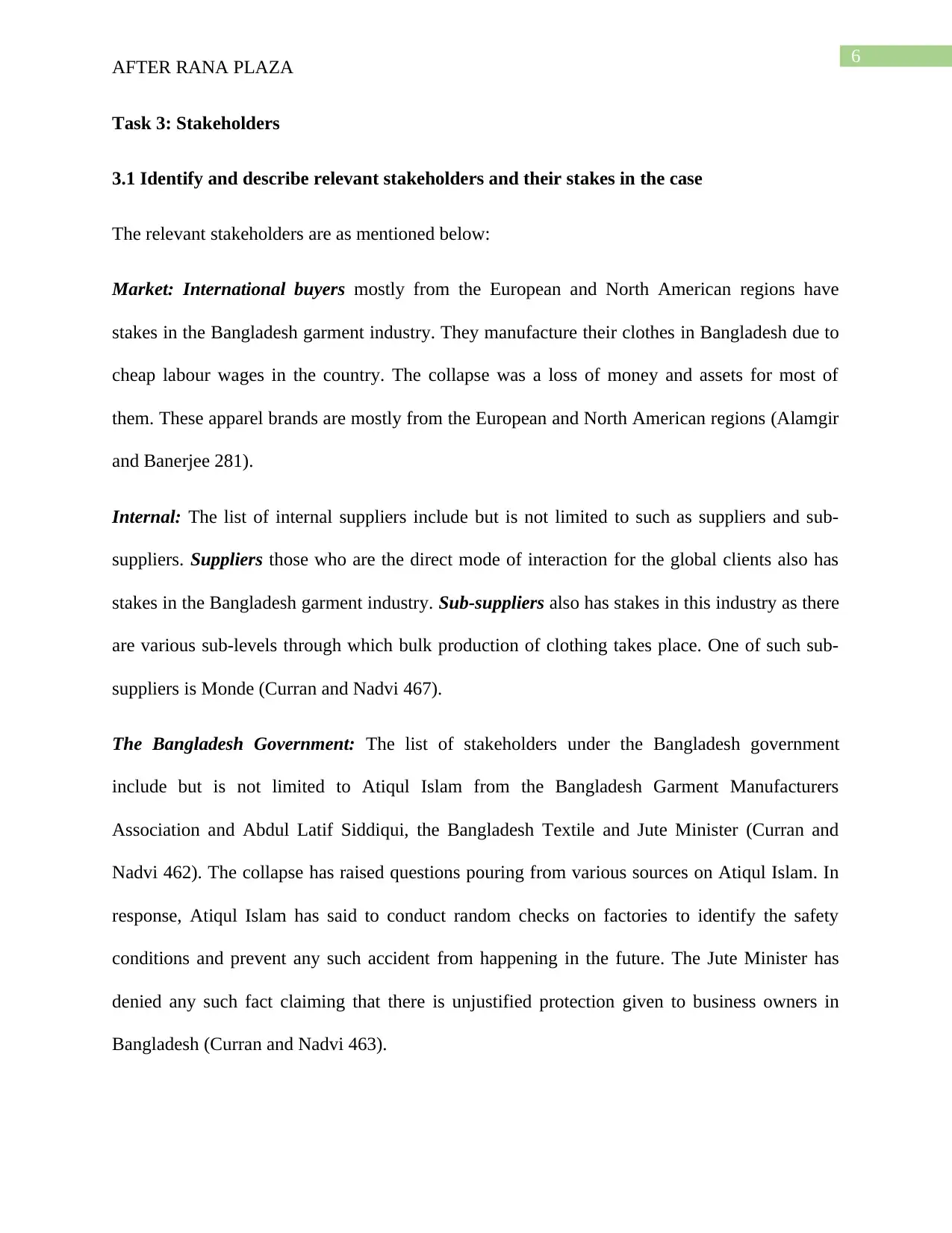
6
AFTER RANA PLAZA
Task 3: Stakeholders
3.1 Identify and describe relevant stakeholders and their stakes in the case
The relevant stakeholders are as mentioned below:
Market: International buyers mostly from the European and North American regions have
stakes in the Bangladesh garment industry. They manufacture their clothes in Bangladesh due to
cheap labour wages in the country. The collapse was a loss of money and assets for most of
them. These apparel brands are mostly from the European and North American regions (Alamgir
and Banerjee 281).
Internal: The list of internal suppliers include but is not limited to such as suppliers and sub-
suppliers. Suppliers those who are the direct mode of interaction for the global clients also has
stakes in the Bangladesh garment industry. Sub-suppliers also has stakes in this industry as there
are various sub-levels through which bulk production of clothing takes place. One of such sub-
suppliers is Monde (Curran and Nadvi 467).
The Bangladesh Government: The list of stakeholders under the Bangladesh government
include but is not limited to Atiqul Islam from the Bangladesh Garment Manufacturers
Association and Abdul Latif Siddiqui, the Bangladesh Textile and Jute Minister (Curran and
Nadvi 462). The collapse has raised questions pouring from various sources on Atiqul Islam. In
response, Atiqul Islam has said to conduct random checks on factories to identify the safety
conditions and prevent any such accident from happening in the future. The Jute Minister has
denied any such fact claiming that there is unjustified protection given to business owners in
Bangladesh (Curran and Nadvi 463).
AFTER RANA PLAZA
Task 3: Stakeholders
3.1 Identify and describe relevant stakeholders and their stakes in the case
The relevant stakeholders are as mentioned below:
Market: International buyers mostly from the European and North American regions have
stakes in the Bangladesh garment industry. They manufacture their clothes in Bangladesh due to
cheap labour wages in the country. The collapse was a loss of money and assets for most of
them. These apparel brands are mostly from the European and North American regions (Alamgir
and Banerjee 281).
Internal: The list of internal suppliers include but is not limited to such as suppliers and sub-
suppliers. Suppliers those who are the direct mode of interaction for the global clients also has
stakes in the Bangladesh garment industry. Sub-suppliers also has stakes in this industry as there
are various sub-levels through which bulk production of clothing takes place. One of such sub-
suppliers is Monde (Curran and Nadvi 467).
The Bangladesh Government: The list of stakeholders under the Bangladesh government
include but is not limited to Atiqul Islam from the Bangladesh Garment Manufacturers
Association and Abdul Latif Siddiqui, the Bangladesh Textile and Jute Minister (Curran and
Nadvi 462). The collapse has raised questions pouring from various sources on Atiqul Islam. In
response, Atiqul Islam has said to conduct random checks on factories to identify the safety
conditions and prevent any such accident from happening in the future. The Jute Minister has
denied any such fact claiming that there is unjustified protection given to business owners in
Bangladesh (Curran and Nadvi 463).
Paraphrase This Document
Need a fresh take? Get an instant paraphrase of this document with our AI Paraphraser
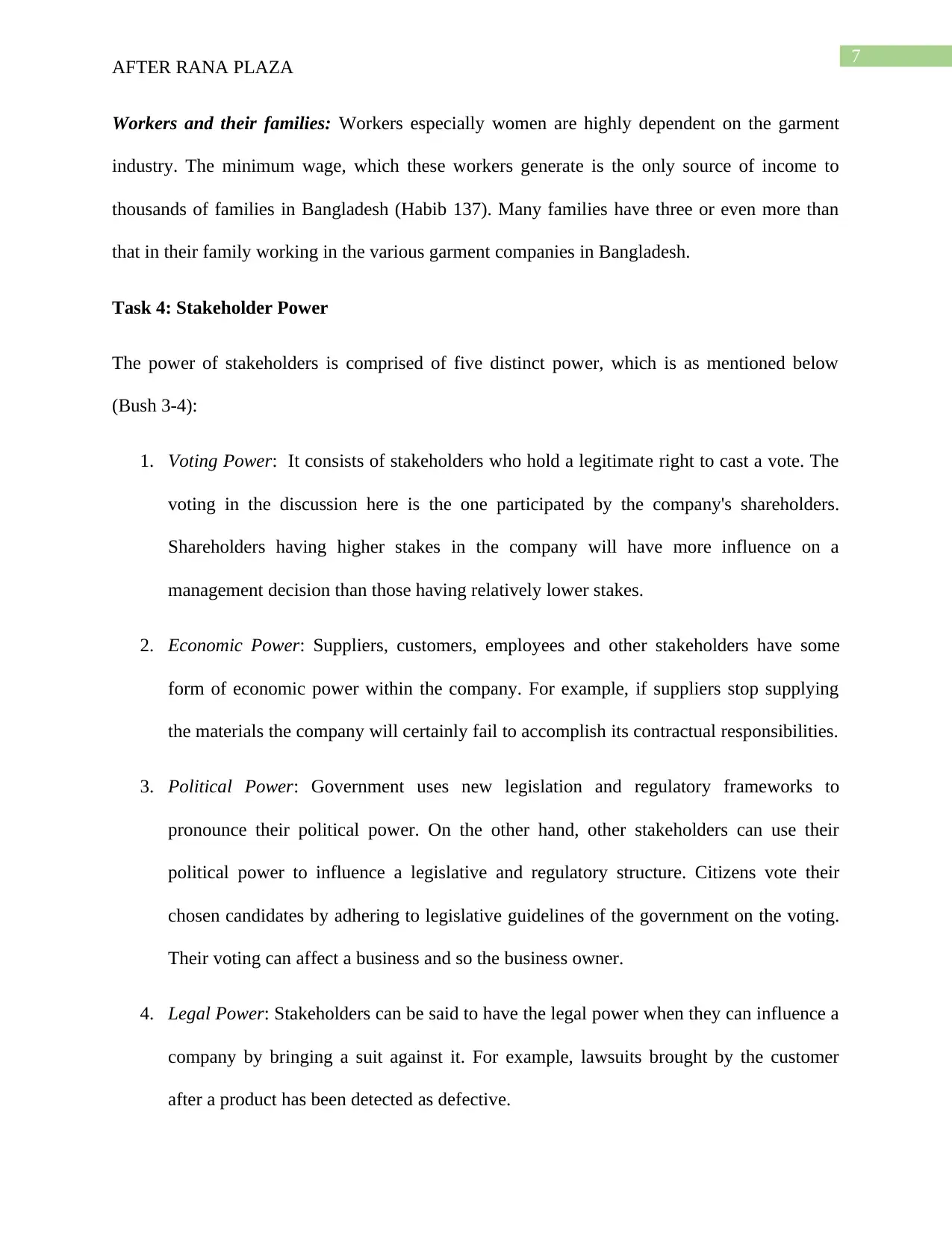
7
AFTER RANA PLAZA
Workers and their families: Workers especially women are highly dependent on the garment
industry. The minimum wage, which these workers generate is the only source of income to
thousands of families in Bangladesh (Habib 137). Many families have three or even more than
that in their family working in the various garment companies in Bangladesh.
Task 4: Stakeholder Power
The power of stakeholders is comprised of five distinct power, which is as mentioned below
(Bush 3-4):
1. Voting Power: It consists of stakeholders who hold a legitimate right to cast a vote. The
voting in the discussion here is the one participated by the company's shareholders.
Shareholders having higher stakes in the company will have more influence on a
management decision than those having relatively lower stakes.
2. Economic Power: Suppliers, customers, employees and other stakeholders have some
form of economic power within the company. For example, if suppliers stop supplying
the materials the company will certainly fail to accomplish its contractual responsibilities.
3. Political Power: Government uses new legislation and regulatory frameworks to
pronounce their political power. On the other hand, other stakeholders can use their
political power to influence a legislative and regulatory structure. Citizens vote their
chosen candidates by adhering to legislative guidelines of the government on the voting.
Their voting can affect a business and so the business owner.
4. Legal Power: Stakeholders can be said to have the legal power when they can influence a
company by bringing a suit against it. For example, lawsuits brought by the customer
after a product has been detected as defective.
AFTER RANA PLAZA
Workers and their families: Workers especially women are highly dependent on the garment
industry. The minimum wage, which these workers generate is the only source of income to
thousands of families in Bangladesh (Habib 137). Many families have three or even more than
that in their family working in the various garment companies in Bangladesh.
Task 4: Stakeholder Power
The power of stakeholders is comprised of five distinct power, which is as mentioned below
(Bush 3-4):
1. Voting Power: It consists of stakeholders who hold a legitimate right to cast a vote. The
voting in the discussion here is the one participated by the company's shareholders.
Shareholders having higher stakes in the company will have more influence on a
management decision than those having relatively lower stakes.
2. Economic Power: Suppliers, customers, employees and other stakeholders have some
form of economic power within the company. For example, if suppliers stop supplying
the materials the company will certainly fail to accomplish its contractual responsibilities.
3. Political Power: Government uses new legislation and regulatory frameworks to
pronounce their political power. On the other hand, other stakeholders can use their
political power to influence a legislative and regulatory structure. Citizens vote their
chosen candidates by adhering to legislative guidelines of the government on the voting.
Their voting can affect a business and so the business owner.
4. Legal Power: Stakeholders can be said to have the legal power when they can influence a
company by bringing a suit against it. For example, lawsuits brought by the customer
after a product has been detected as defective.
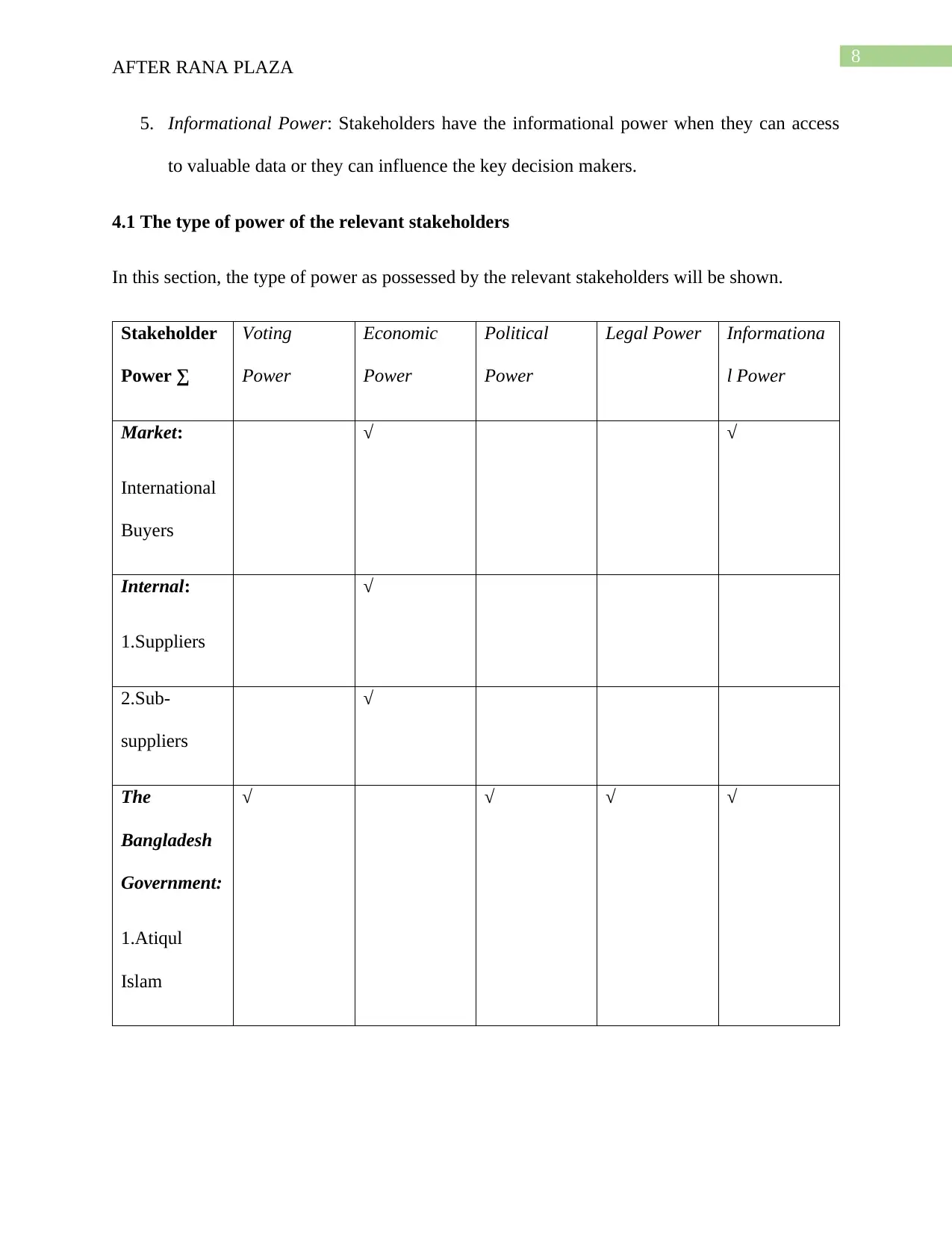
8
AFTER RANA PLAZA
5. Informational Power: Stakeholders have the informational power when they can access
to valuable data or they can influence the key decision makers.
4.1 The type of power of the relevant stakeholders
In this section, the type of power as possessed by the relevant stakeholders will be shown.
Stakeholder
Power ∑
Voting
Power
Economic
Power
Political
Power
Legal Power Informationa
l Power
Market:
International
Buyers
√ √
Internal:
1.Suppliers
√
2.Sub-
suppliers
√
The
Bangladesh
Government:
1.Atiqul
Islam
√ √ √ √
AFTER RANA PLAZA
5. Informational Power: Stakeholders have the informational power when they can access
to valuable data or they can influence the key decision makers.
4.1 The type of power of the relevant stakeholders
In this section, the type of power as possessed by the relevant stakeholders will be shown.
Stakeholder
Power ∑
Voting
Power
Economic
Power
Political
Power
Legal Power Informationa
l Power
Market:
International
Buyers
√ √
Internal:
1.Suppliers
√
2.Sub-
suppliers
√
The
Bangladesh
Government:
1.Atiqul
Islam
√ √ √ √
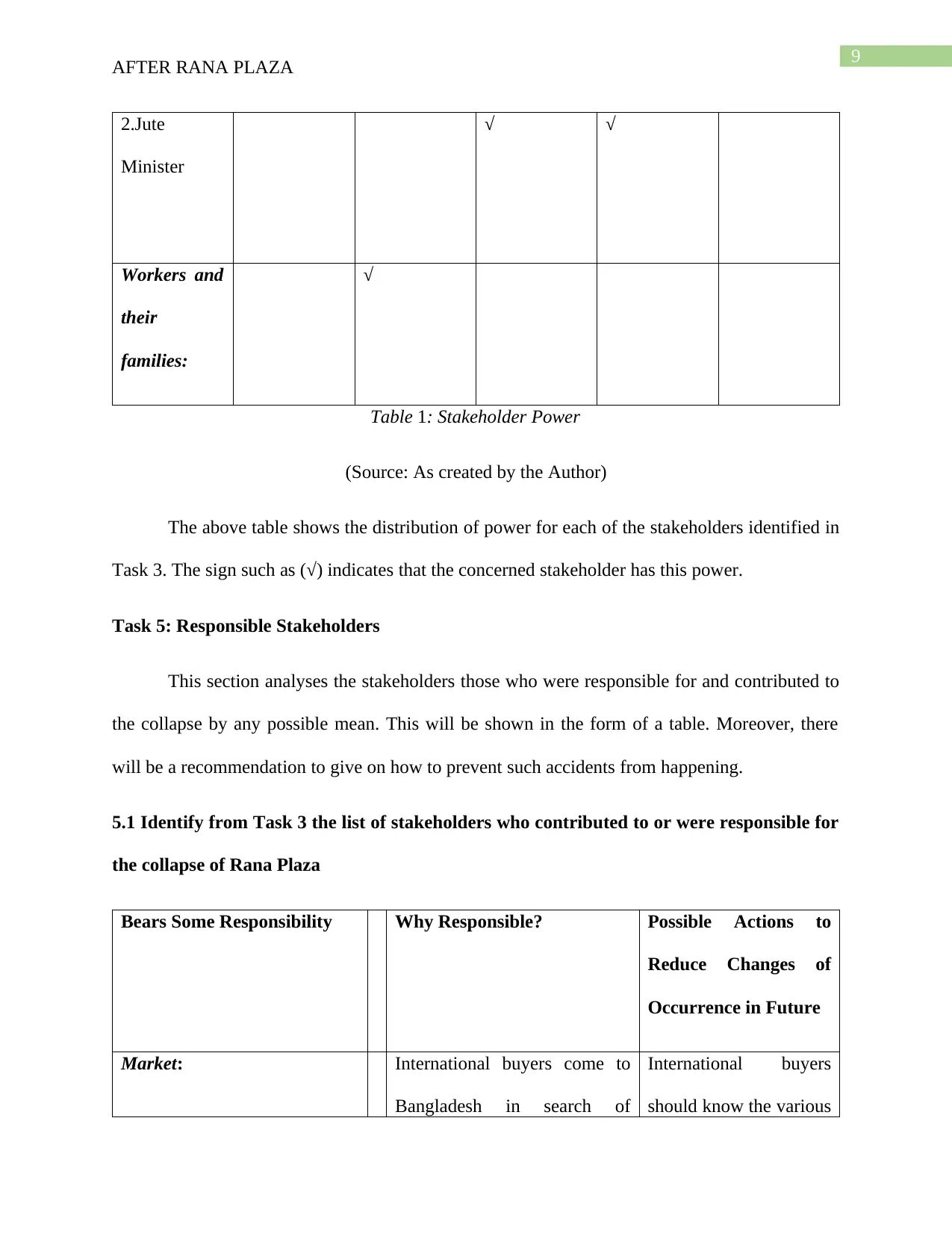
9
AFTER RANA PLAZA
2.Jute
Minister
√ √
Workers and
their
families:
√
Table 1: Stakeholder Power
(Source: As created by the Author)
The above table shows the distribution of power for each of the stakeholders identified in
Task 3. The sign such as (√) indicates that the concerned stakeholder has this power.
Task 5: Responsible Stakeholders
This section analyses the stakeholders those who were responsible for and contributed to
the collapse by any possible mean. This will be shown in the form of a table. Moreover, there
will be a recommendation to give on how to prevent such accidents from happening.
5.1 Identify from Task 3 the list of stakeholders who contributed to or were responsible for
the collapse of Rana Plaza
Bears Some Responsibility Why Responsible? Possible Actions to
Reduce Changes of
Occurrence in Future
Market: International buyers come to
Bangladesh in search of
International buyers
should know the various
AFTER RANA PLAZA
2.Jute
Minister
√ √
Workers and
their
families:
√
Table 1: Stakeholder Power
(Source: As created by the Author)
The above table shows the distribution of power for each of the stakeholders identified in
Task 3. The sign such as (√) indicates that the concerned stakeholder has this power.
Task 5: Responsible Stakeholders
This section analyses the stakeholders those who were responsible for and contributed to
the collapse by any possible mean. This will be shown in the form of a table. Moreover, there
will be a recommendation to give on how to prevent such accidents from happening.
5.1 Identify from Task 3 the list of stakeholders who contributed to or were responsible for
the collapse of Rana Plaza
Bears Some Responsibility Why Responsible? Possible Actions to
Reduce Changes of
Occurrence in Future
Market: International buyers come to
Bangladesh in search of
International buyers
should know the various
Secure Best Marks with AI Grader
Need help grading? Try our AI Grader for instant feedback on your assignments.
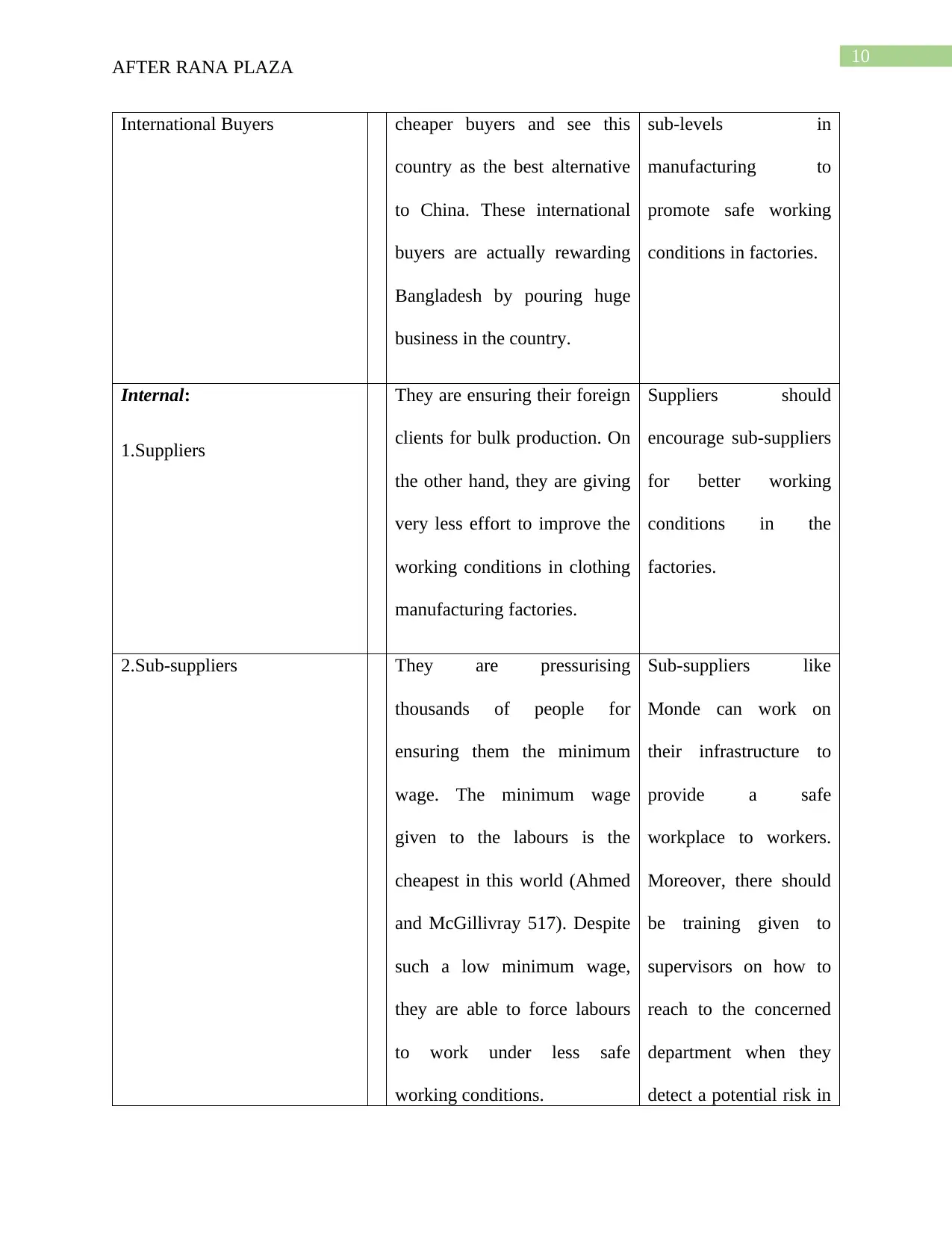
10
AFTER RANA PLAZA
International Buyers cheaper buyers and see this
country as the best alternative
to China. These international
buyers are actually rewarding
Bangladesh by pouring huge
business in the country.
sub-levels in
manufacturing to
promote safe working
conditions in factories.
Internal:
1.Suppliers
They are ensuring their foreign
clients for bulk production. On
the other hand, they are giving
very less effort to improve the
working conditions in clothing
manufacturing factories.
Suppliers should
encourage sub-suppliers
for better working
conditions in the
factories.
2.Sub-suppliers They are pressurising
thousands of people for
ensuring them the minimum
wage. The minimum wage
given to the labours is the
cheapest in this world (Ahmed
and McGillivray 517). Despite
such a low minimum wage,
they are able to force labours
to work under less safe
working conditions.
Sub-suppliers like
Monde can work on
their infrastructure to
provide a safe
workplace to workers.
Moreover, there should
be training given to
supervisors on how to
reach to the concerned
department when they
detect a potential risk in
AFTER RANA PLAZA
International Buyers cheaper buyers and see this
country as the best alternative
to China. These international
buyers are actually rewarding
Bangladesh by pouring huge
business in the country.
sub-levels in
manufacturing to
promote safe working
conditions in factories.
Internal:
1.Suppliers
They are ensuring their foreign
clients for bulk production. On
the other hand, they are giving
very less effort to improve the
working conditions in clothing
manufacturing factories.
Suppliers should
encourage sub-suppliers
for better working
conditions in the
factories.
2.Sub-suppliers They are pressurising
thousands of people for
ensuring them the minimum
wage. The minimum wage
given to the labours is the
cheapest in this world (Ahmed
and McGillivray 517). Despite
such a low minimum wage,
they are able to force labours
to work under less safe
working conditions.
Sub-suppliers like
Monde can work on
their infrastructure to
provide a safe
workplace to workers.
Moreover, there should
be training given to
supervisors on how to
reach to the concerned
department when they
detect a potential risk in
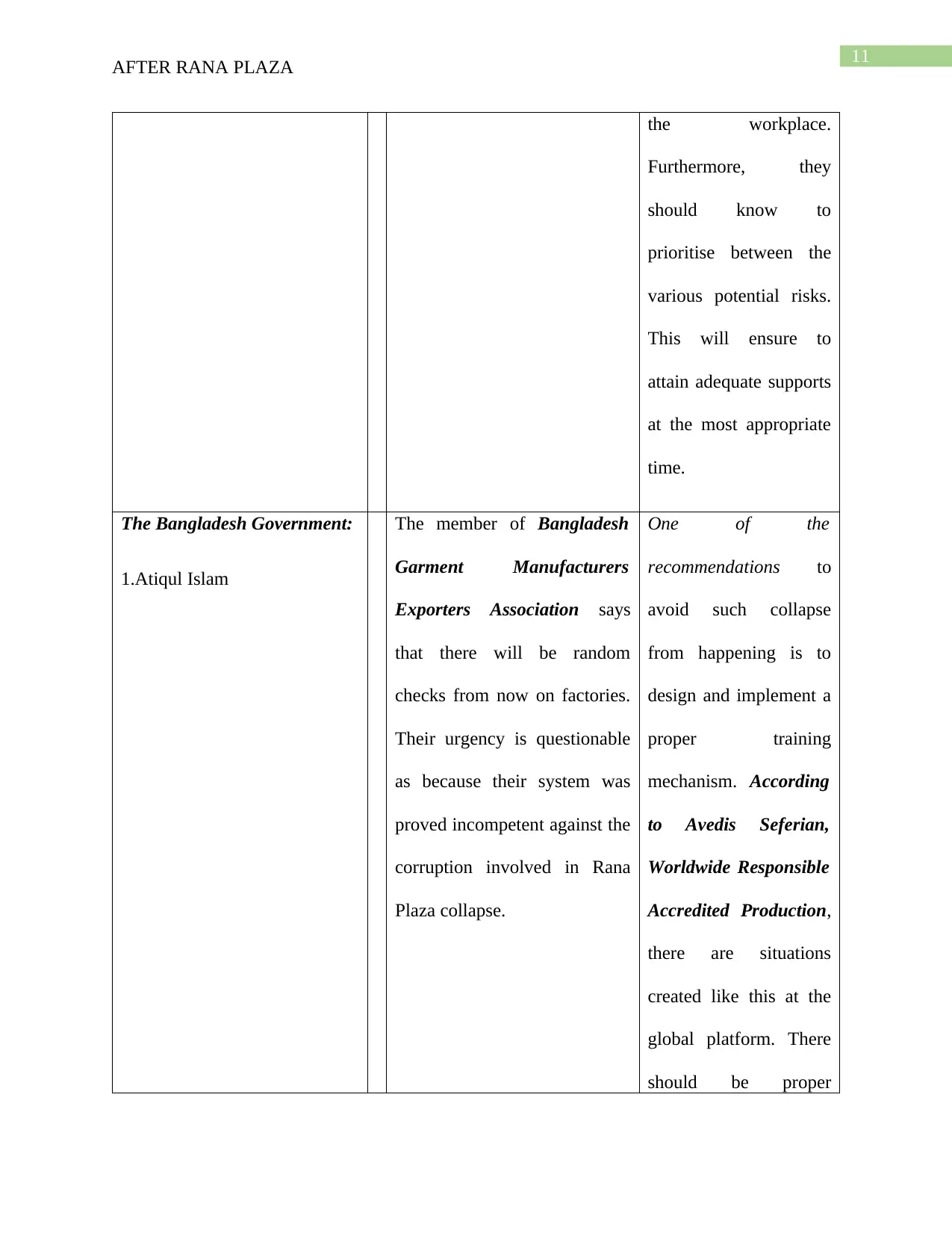
11
AFTER RANA PLAZA
the workplace.
Furthermore, they
should know to
prioritise between the
various potential risks.
This will ensure to
attain adequate supports
at the most appropriate
time.
The Bangladesh Government:
1.Atiqul Islam
The member of Bangladesh
Garment Manufacturers
Exporters Association says
that there will be random
checks from now on factories.
Their urgency is questionable
as because their system was
proved incompetent against the
corruption involved in Rana
Plaza collapse.
One of the
recommendations to
avoid such collapse
from happening is to
design and implement a
proper training
mechanism. According
to Avedis Seferian,
Worldwide Responsible
Accredited Production,
there are situations
created like this at the
global platform. There
should be proper
AFTER RANA PLAZA
the workplace.
Furthermore, they
should know to
prioritise between the
various potential risks.
This will ensure to
attain adequate supports
at the most appropriate
time.
The Bangladesh Government:
1.Atiqul Islam
The member of Bangladesh
Garment Manufacturers
Exporters Association says
that there will be random
checks from now on factories.
Their urgency is questionable
as because their system was
proved incompetent against the
corruption involved in Rana
Plaza collapse.
One of the
recommendations to
avoid such collapse
from happening is to
design and implement a
proper training
mechanism. According
to Avedis Seferian,
Worldwide Responsible
Accredited Production,
there are situations
created like this at the
global platform. There
should be proper
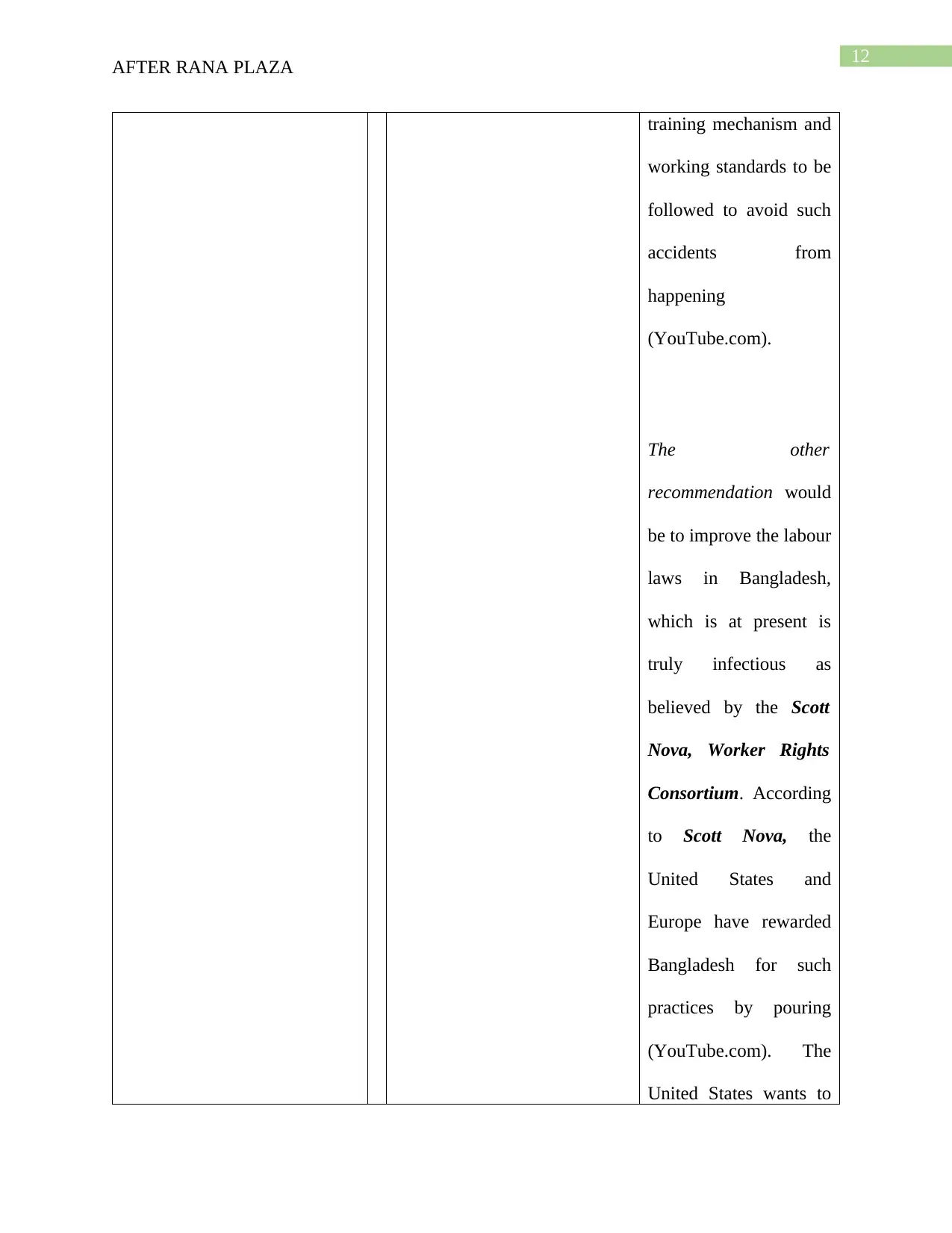
12
AFTER RANA PLAZA
training mechanism and
working standards to be
followed to avoid such
accidents from
happening
(YouTube.com).
The other
recommendation would
be to improve the labour
laws in Bangladesh,
which is at present is
truly infectious as
believed by the Scott
Nova, Worker Rights
Consortium. According
to Scott Nova, the
United States and
Europe have rewarded
Bangladesh for such
practices by pouring
(YouTube.com). The
United States wants to
AFTER RANA PLAZA
training mechanism and
working standards to be
followed to avoid such
accidents from
happening
(YouTube.com).
The other
recommendation would
be to improve the labour
laws in Bangladesh,
which is at present is
truly infectious as
believed by the Scott
Nova, Worker Rights
Consortium. According
to Scott Nova, the
United States and
Europe have rewarded
Bangladesh for such
practices by pouring
(YouTube.com). The
United States wants to
Paraphrase This Document
Need a fresh take? Get an instant paraphrase of this document with our AI Paraphraser
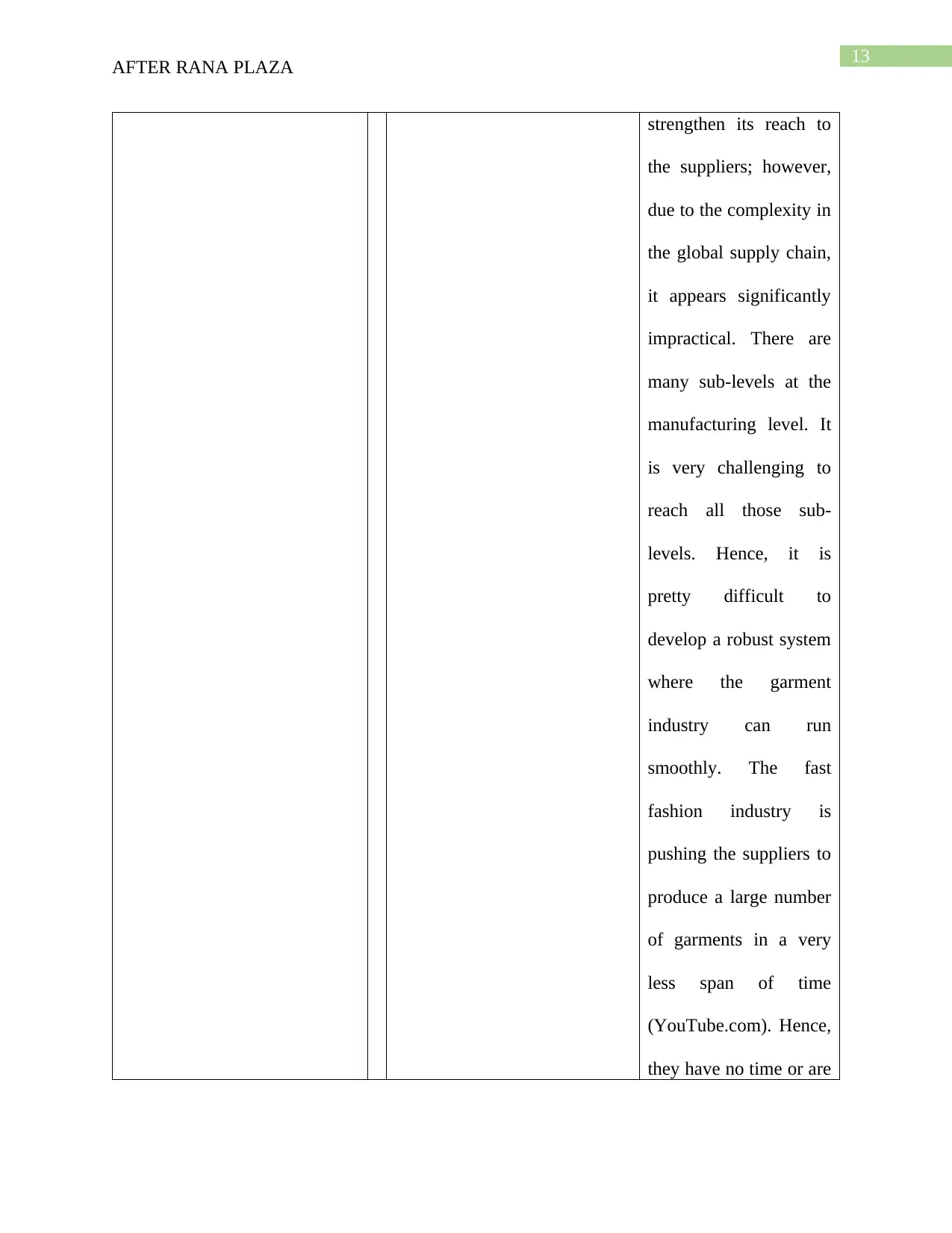
13
AFTER RANA PLAZA
strengthen its reach to
the suppliers; however,
due to the complexity in
the global supply chain,
it appears significantly
impractical. There are
many sub-levels at the
manufacturing level. It
is very challenging to
reach all those sub-
levels. Hence, it is
pretty difficult to
develop a robust system
where the garment
industry can run
smoothly. The fast
fashion industry is
pushing the suppliers to
produce a large number
of garments in a very
less span of time
(YouTube.com). Hence,
they have no time or are
AFTER RANA PLAZA
strengthen its reach to
the suppliers; however,
due to the complexity in
the global supply chain,
it appears significantly
impractical. There are
many sub-levels at the
manufacturing level. It
is very challenging to
reach all those sub-
levels. Hence, it is
pretty difficult to
develop a robust system
where the garment
industry can run
smoothly. The fast
fashion industry is
pushing the suppliers to
produce a large number
of garments in a very
less span of time
(YouTube.com). Hence,
they have no time or are
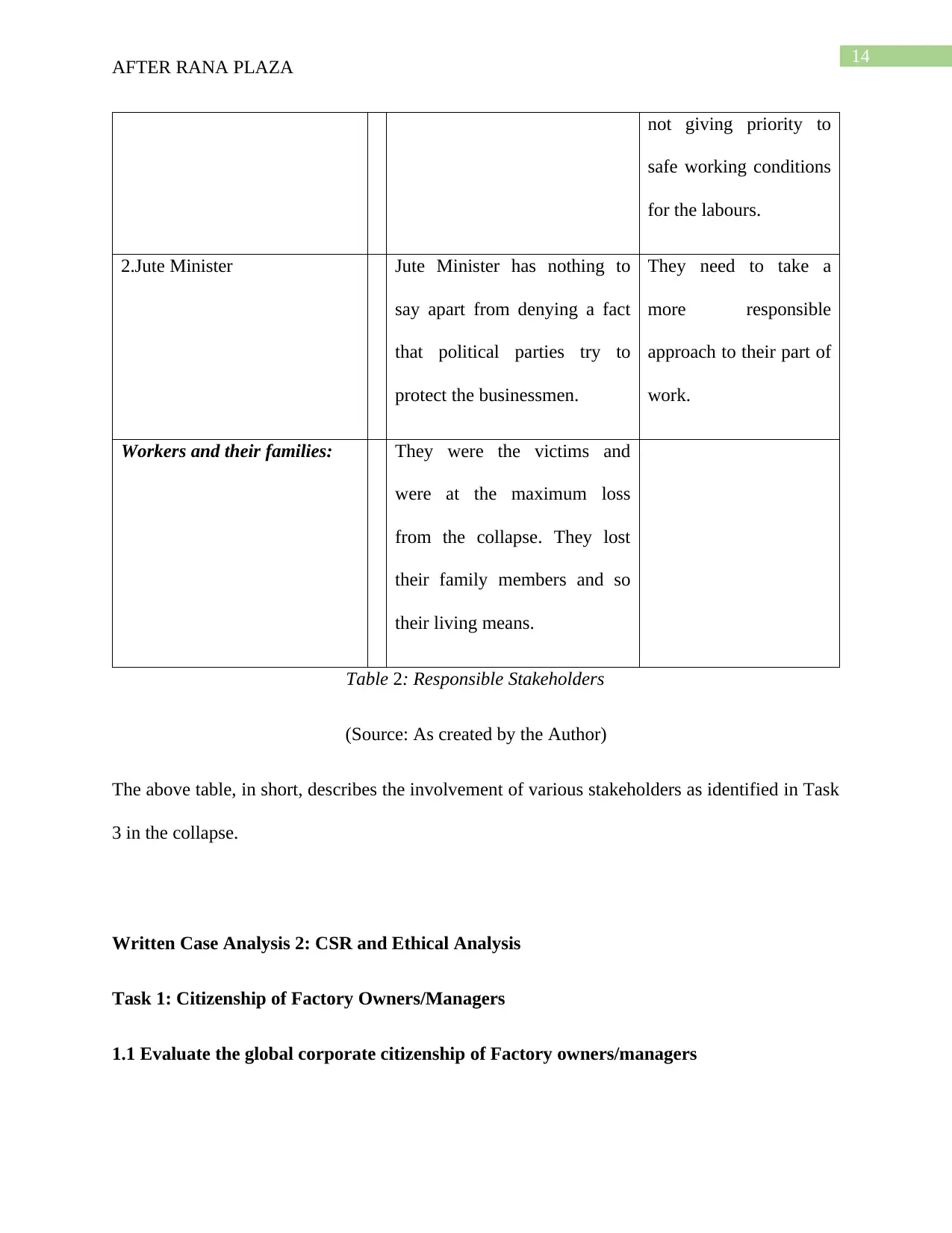
14
AFTER RANA PLAZA
not giving priority to
safe working conditions
for the labours.
2.Jute Minister Jute Minister has nothing to
say apart from denying a fact
that political parties try to
protect the businessmen.
They need to take a
more responsible
approach to their part of
work.
Workers and their families: They were the victims and
were at the maximum loss
from the collapse. They lost
their family members and so
their living means.
Table 2: Responsible Stakeholders
(Source: As created by the Author)
The above table, in short, describes the involvement of various stakeholders as identified in Task
3 in the collapse.
Written Case Analysis 2: CSR and Ethical Analysis
Task 1: Citizenship of Factory Owners/Managers
1.1 Evaluate the global corporate citizenship of Factory owners/managers
AFTER RANA PLAZA
not giving priority to
safe working conditions
for the labours.
2.Jute Minister Jute Minister has nothing to
say apart from denying a fact
that political parties try to
protect the businessmen.
They need to take a
more responsible
approach to their part of
work.
Workers and their families: They were the victims and
were at the maximum loss
from the collapse. They lost
their family members and so
their living means.
Table 2: Responsible Stakeholders
(Source: As created by the Author)
The above table, in short, describes the involvement of various stakeholders as identified in Task
3 in the collapse.
Written Case Analysis 2: CSR and Ethical Analysis
Task 1: Citizenship of Factory Owners/Managers
1.1 Evaluate the global corporate citizenship of Factory owners/managers
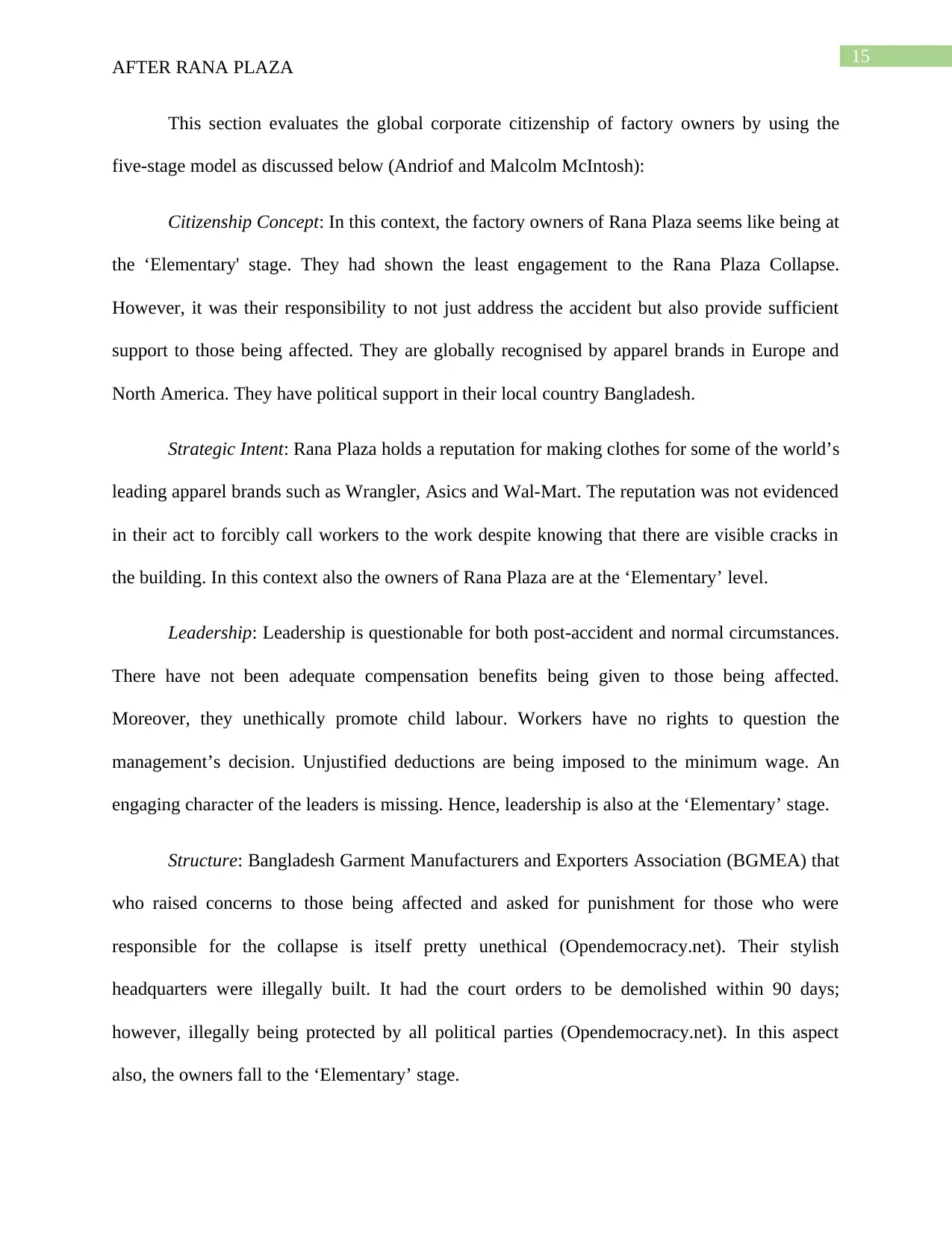
15
AFTER RANA PLAZA
This section evaluates the global corporate citizenship of factory owners by using the
five-stage model as discussed below (Andriof and Malcolm McIntosh):
Citizenship Concept: In this context, the factory owners of Rana Plaza seems like being at
the ‘Elementary' stage. They had shown the least engagement to the Rana Plaza Collapse.
However, it was their responsibility to not just address the accident but also provide sufficient
support to those being affected. They are globally recognised by apparel brands in Europe and
North America. They have political support in their local country Bangladesh.
Strategic Intent: Rana Plaza holds a reputation for making clothes for some of the world’s
leading apparel brands such as Wrangler, Asics and Wal-Mart. The reputation was not evidenced
in their act to forcibly call workers to the work despite knowing that there are visible cracks in
the building. In this context also the owners of Rana Plaza are at the ‘Elementary’ level.
Leadership: Leadership is questionable for both post-accident and normal circumstances.
There have not been adequate compensation benefits being given to those being affected.
Moreover, they unethically promote child labour. Workers have no rights to question the
management’s decision. Unjustified deductions are being imposed to the minimum wage. An
engaging character of the leaders is missing. Hence, leadership is also at the ‘Elementary’ stage.
Structure: Bangladesh Garment Manufacturers and Exporters Association (BGMEA) that
who raised concerns to those being affected and asked for punishment for those who were
responsible for the collapse is itself pretty unethical (Opendemocracy.net). Their stylish
headquarters were illegally built. It had the court orders to be demolished within 90 days;
however, illegally being protected by all political parties (Opendemocracy.net). In this aspect
also, the owners fall to the ‘Elementary’ stage.
AFTER RANA PLAZA
This section evaluates the global corporate citizenship of factory owners by using the
five-stage model as discussed below (Andriof and Malcolm McIntosh):
Citizenship Concept: In this context, the factory owners of Rana Plaza seems like being at
the ‘Elementary' stage. They had shown the least engagement to the Rana Plaza Collapse.
However, it was their responsibility to not just address the accident but also provide sufficient
support to those being affected. They are globally recognised by apparel brands in Europe and
North America. They have political support in their local country Bangladesh.
Strategic Intent: Rana Plaza holds a reputation for making clothes for some of the world’s
leading apparel brands such as Wrangler, Asics and Wal-Mart. The reputation was not evidenced
in their act to forcibly call workers to the work despite knowing that there are visible cracks in
the building. In this context also the owners of Rana Plaza are at the ‘Elementary’ level.
Leadership: Leadership is questionable for both post-accident and normal circumstances.
There have not been adequate compensation benefits being given to those being affected.
Moreover, they unethically promote child labour. Workers have no rights to question the
management’s decision. Unjustified deductions are being imposed to the minimum wage. An
engaging character of the leaders is missing. Hence, leadership is also at the ‘Elementary’ stage.
Structure: Bangladesh Garment Manufacturers and Exporters Association (BGMEA) that
who raised concerns to those being affected and asked for punishment for those who were
responsible for the collapse is itself pretty unethical (Opendemocracy.net). Their stylish
headquarters were illegally built. It had the court orders to be demolished within 90 days;
however, illegally being protected by all political parties (Opendemocracy.net). In this aspect
also, the owners fall to the ‘Elementary’ stage.
Secure Best Marks with AI Grader
Need help grading? Try our AI Grader for instant feedback on your assignments.
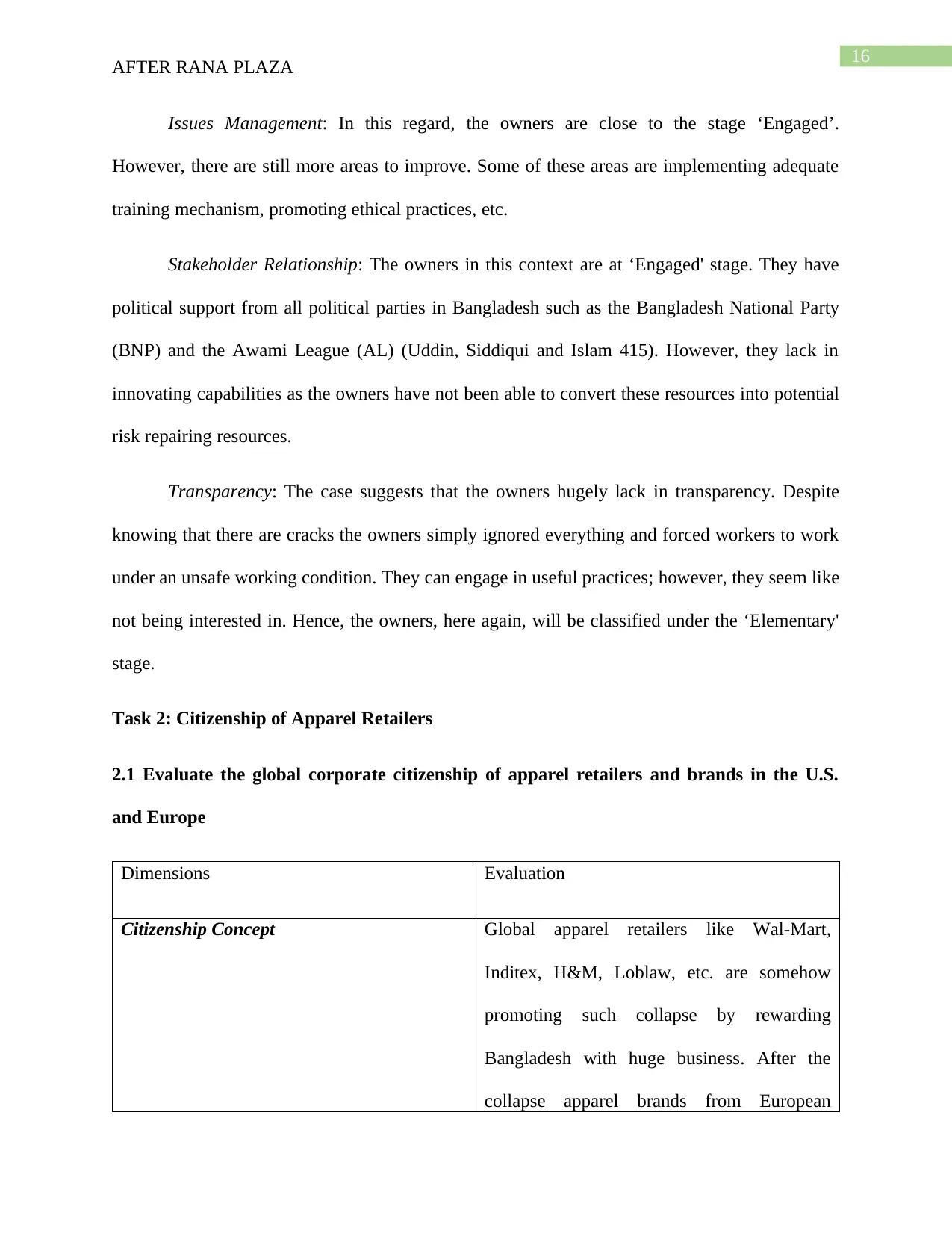
16
AFTER RANA PLAZA
Issues Management: In this regard, the owners are close to the stage ‘Engaged’.
However, there are still more areas to improve. Some of these areas are implementing adequate
training mechanism, promoting ethical practices, etc.
Stakeholder Relationship: The owners in this context are at ‘Engaged' stage. They have
political support from all political parties in Bangladesh such as the Bangladesh National Party
(BNP) and the Awami League (AL) (Uddin, Siddiqui and Islam 415). However, they lack in
innovating capabilities as the owners have not been able to convert these resources into potential
risk repairing resources.
Transparency: The case suggests that the owners hugely lack in transparency. Despite
knowing that there are cracks the owners simply ignored everything and forced workers to work
under an unsafe working condition. They can engage in useful practices; however, they seem like
not being interested in. Hence, the owners, here again, will be classified under the ‘Elementary'
stage.
Task 2: Citizenship of Apparel Retailers
2.1 Evaluate the global corporate citizenship of apparel retailers and brands in the U.S.
and Europe
Dimensions Evaluation
Citizenship Concept Global apparel retailers like Wal-Mart,
Inditex, H&M, Loblaw, etc. are somehow
promoting such collapse by rewarding
Bangladesh with huge business. After the
collapse apparel brands from European
AFTER RANA PLAZA
Issues Management: In this regard, the owners are close to the stage ‘Engaged’.
However, there are still more areas to improve. Some of these areas are implementing adequate
training mechanism, promoting ethical practices, etc.
Stakeholder Relationship: The owners in this context are at ‘Engaged' stage. They have
political support from all political parties in Bangladesh such as the Bangladesh National Party
(BNP) and the Awami League (AL) (Uddin, Siddiqui and Islam 415). However, they lack in
innovating capabilities as the owners have not been able to convert these resources into potential
risk repairing resources.
Transparency: The case suggests that the owners hugely lack in transparency. Despite
knowing that there are cracks the owners simply ignored everything and forced workers to work
under an unsafe working condition. They can engage in useful practices; however, they seem like
not being interested in. Hence, the owners, here again, will be classified under the ‘Elementary'
stage.
Task 2: Citizenship of Apparel Retailers
2.1 Evaluate the global corporate citizenship of apparel retailers and brands in the U.S.
and Europe
Dimensions Evaluation
Citizenship Concept Global apparel retailers like Wal-Mart,
Inditex, H&M, Loblaw, etc. are somehow
promoting such collapse by rewarding
Bangladesh with huge business. After the
collapse apparel brands from European
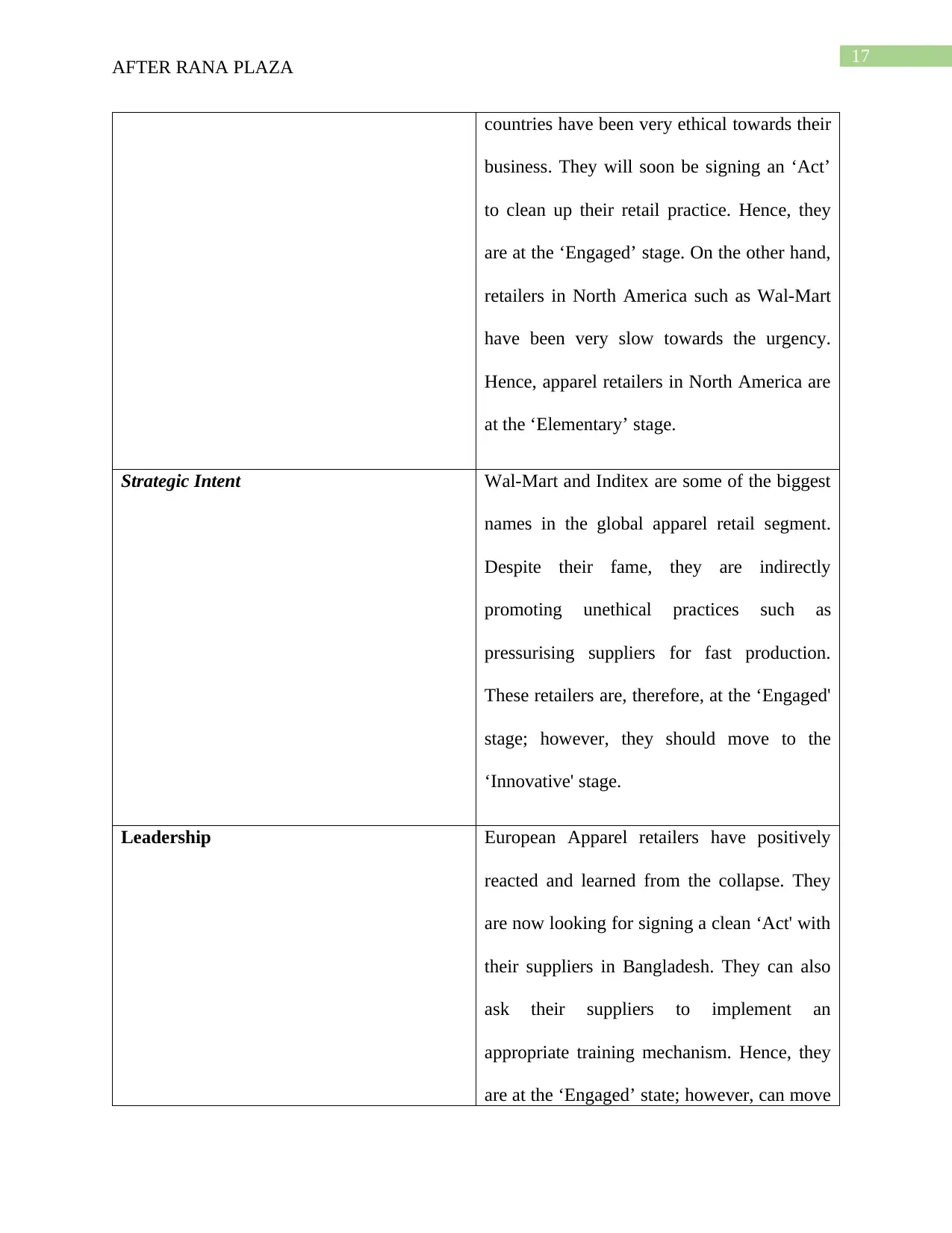
17
AFTER RANA PLAZA
countries have been very ethical towards their
business. They will soon be signing an ‘Act’
to clean up their retail practice. Hence, they
are at the ‘Engaged’ stage. On the other hand,
retailers in North America such as Wal-Mart
have been very slow towards the urgency.
Hence, apparel retailers in North America are
at the ‘Elementary’ stage.
Strategic Intent Wal-Mart and Inditex are some of the biggest
names in the global apparel retail segment.
Despite their fame, they are indirectly
promoting unethical practices such as
pressurising suppliers for fast production.
These retailers are, therefore, at the ‘Engaged'
stage; however, they should move to the
‘Innovative' stage.
Leadership European Apparel retailers have positively
reacted and learned from the collapse. They
are now looking for signing a clean ‘Act' with
their suppliers in Bangladesh. They can also
ask their suppliers to implement an
appropriate training mechanism. Hence, they
are at the ‘Engaged’ state; however, can move
AFTER RANA PLAZA
countries have been very ethical towards their
business. They will soon be signing an ‘Act’
to clean up their retail practice. Hence, they
are at the ‘Engaged’ stage. On the other hand,
retailers in North America such as Wal-Mart
have been very slow towards the urgency.
Hence, apparel retailers in North America are
at the ‘Elementary’ stage.
Strategic Intent Wal-Mart and Inditex are some of the biggest
names in the global apparel retail segment.
Despite their fame, they are indirectly
promoting unethical practices such as
pressurising suppliers for fast production.
These retailers are, therefore, at the ‘Engaged'
stage; however, they should move to the
‘Innovative' stage.
Leadership European Apparel retailers have positively
reacted and learned from the collapse. They
are now looking for signing a clean ‘Act' with
their suppliers in Bangladesh. They can also
ask their suppliers to implement an
appropriate training mechanism. Hence, they
are at the ‘Engaged’ state; however, can move
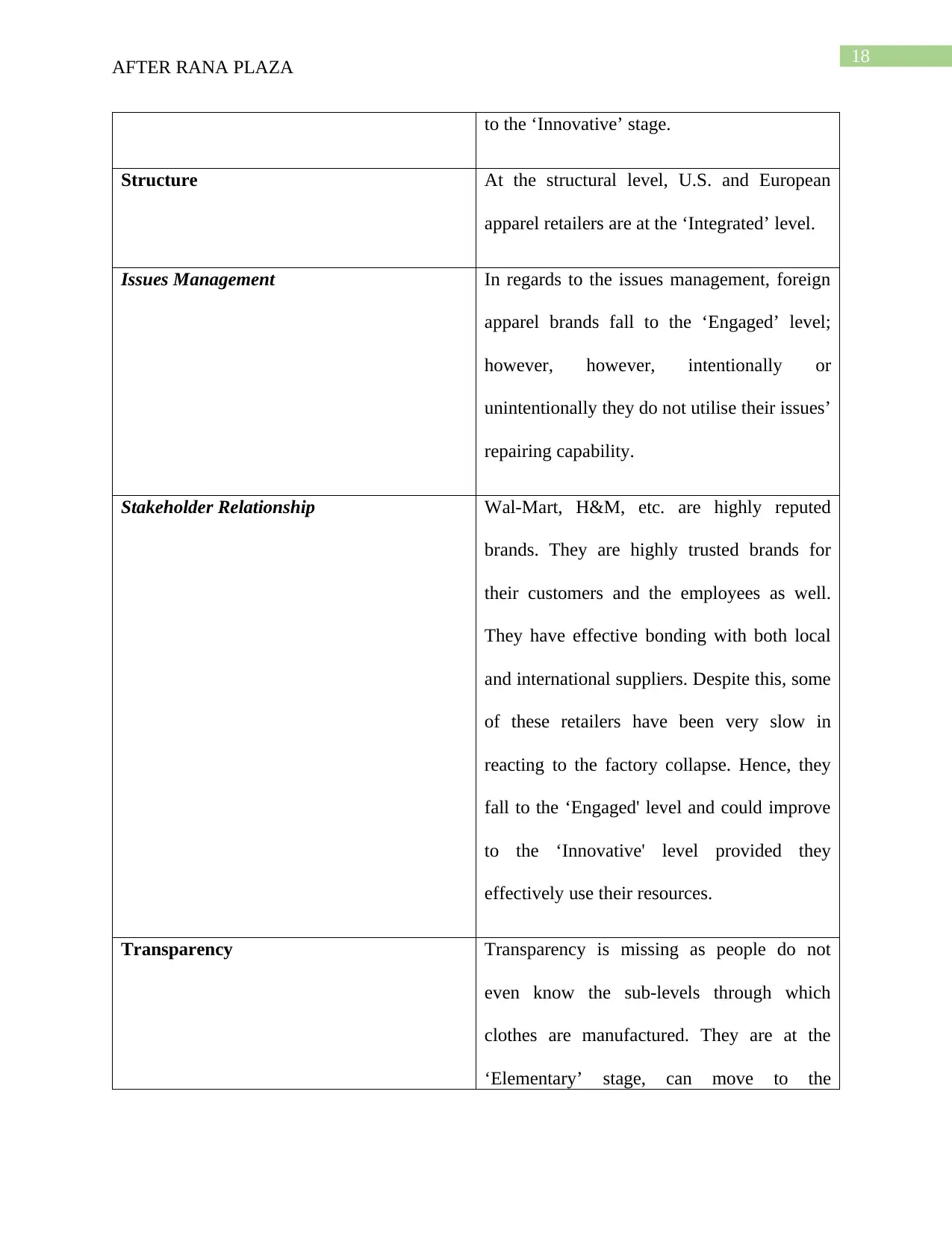
18
AFTER RANA PLAZA
to the ‘Innovative’ stage.
Structure At the structural level, U.S. and European
apparel retailers are at the ‘Integrated’ level.
Issues Management In regards to the issues management, foreign
apparel brands fall to the ‘Engaged’ level;
however, however, intentionally or
unintentionally they do not utilise their issues’
repairing capability.
Stakeholder Relationship Wal-Mart, H&M, etc. are highly reputed
brands. They are highly trusted brands for
their customers and the employees as well.
They have effective bonding with both local
and international suppliers. Despite this, some
of these retailers have been very slow in
reacting to the factory collapse. Hence, they
fall to the ‘Engaged' level and could improve
to the ‘Innovative' level provided they
effectively use their resources.
Transparency Transparency is missing as people do not
even know the sub-levels through which
clothes are manufactured. They are at the
‘Elementary’ stage, can move to the
AFTER RANA PLAZA
to the ‘Innovative’ stage.
Structure At the structural level, U.S. and European
apparel retailers are at the ‘Integrated’ level.
Issues Management In regards to the issues management, foreign
apparel brands fall to the ‘Engaged’ level;
however, however, intentionally or
unintentionally they do not utilise their issues’
repairing capability.
Stakeholder Relationship Wal-Mart, H&M, etc. are highly reputed
brands. They are highly trusted brands for
their customers and the employees as well.
They have effective bonding with both local
and international suppliers. Despite this, some
of these retailers have been very slow in
reacting to the factory collapse. Hence, they
fall to the ‘Engaged' level and could improve
to the ‘Innovative' level provided they
effectively use their resources.
Transparency Transparency is missing as people do not
even know the sub-levels through which
clothes are manufactured. They are at the
‘Elementary’ stage, can move to the
Paraphrase This Document
Need a fresh take? Get an instant paraphrase of this document with our AI Paraphraser
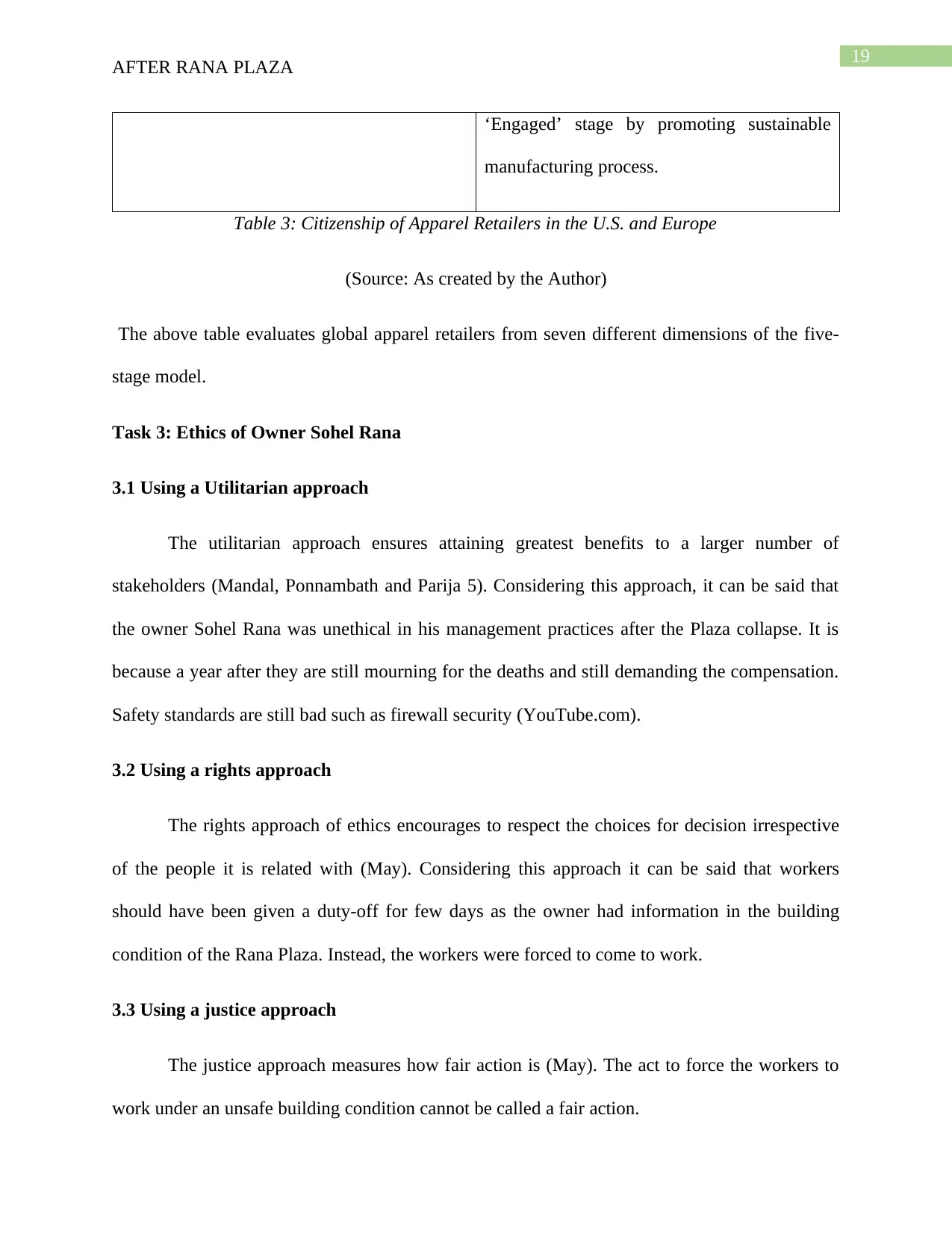
19
AFTER RANA PLAZA
‘Engaged’ stage by promoting sustainable
manufacturing process.
Table 3: Citizenship of Apparel Retailers in the U.S. and Europe
(Source: As created by the Author)
The above table evaluates global apparel retailers from seven different dimensions of the five-
stage model.
Task 3: Ethics of Owner Sohel Rana
3.1 Using a Utilitarian approach
The utilitarian approach ensures attaining greatest benefits to a larger number of
stakeholders (Mandal, Ponnambath and Parija 5). Considering this approach, it can be said that
the owner Sohel Rana was unethical in his management practices after the Plaza collapse. It is
because a year after they are still mourning for the deaths and still demanding the compensation.
Safety standards are still bad such as firewall security (YouTube.com).
3.2 Using a rights approach
The rights approach of ethics encourages to respect the choices for decision irrespective
of the people it is related with (May). Considering this approach it can be said that workers
should have been given a duty-off for few days as the owner had information in the building
condition of the Rana Plaza. Instead, the workers were forced to come to work.
3.3 Using a justice approach
The justice approach measures how fair action is (May). The act to force the workers to
work under an unsafe building condition cannot be called a fair action.
AFTER RANA PLAZA
‘Engaged’ stage by promoting sustainable
manufacturing process.
Table 3: Citizenship of Apparel Retailers in the U.S. and Europe
(Source: As created by the Author)
The above table evaluates global apparel retailers from seven different dimensions of the five-
stage model.
Task 3: Ethics of Owner Sohel Rana
3.1 Using a Utilitarian approach
The utilitarian approach ensures attaining greatest benefits to a larger number of
stakeholders (Mandal, Ponnambath and Parija 5). Considering this approach, it can be said that
the owner Sohel Rana was unethical in his management practices after the Plaza collapse. It is
because a year after they are still mourning for the deaths and still demanding the compensation.
Safety standards are still bad such as firewall security (YouTube.com).
3.2 Using a rights approach
The rights approach of ethics encourages to respect the choices for decision irrespective
of the people it is related with (May). Considering this approach it can be said that workers
should have been given a duty-off for few days as the owner had information in the building
condition of the Rana Plaza. Instead, the workers were forced to come to work.
3.3 Using a justice approach
The justice approach measures how fair action is (May). The act to force the workers to
work under an unsafe building condition cannot be called a fair action.
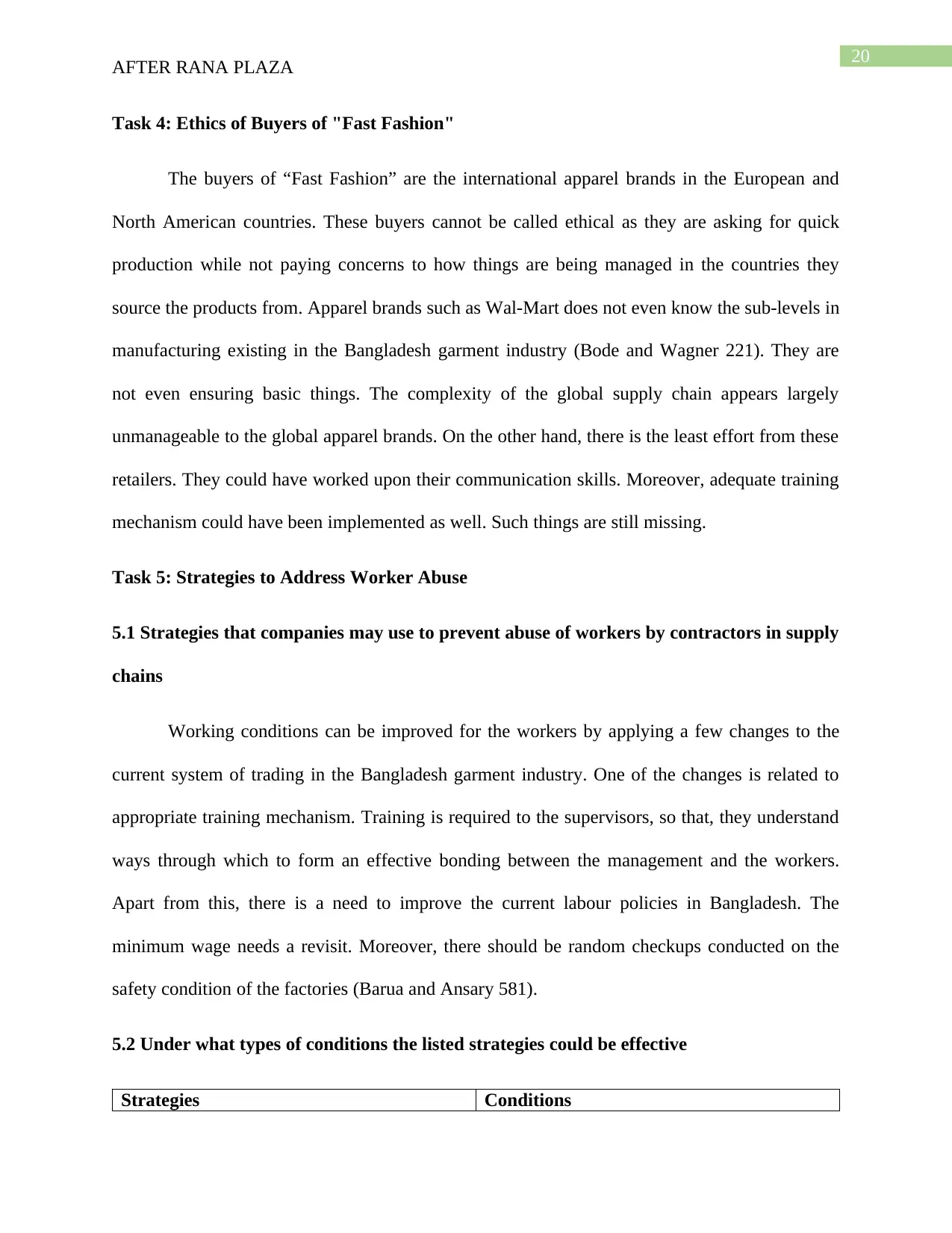
20
AFTER RANA PLAZA
Task 4: Ethics of Buyers of "Fast Fashion"
The buyers of “Fast Fashion” are the international apparel brands in the European and
North American countries. These buyers cannot be called ethical as they are asking for quick
production while not paying concerns to how things are being managed in the countries they
source the products from. Apparel brands such as Wal-Mart does not even know the sub-levels in
manufacturing existing in the Bangladesh garment industry (Bode and Wagner 221). They are
not even ensuring basic things. The complexity of the global supply chain appears largely
unmanageable to the global apparel brands. On the other hand, there is the least effort from these
retailers. They could have worked upon their communication skills. Moreover, adequate training
mechanism could have been implemented as well. Such things are still missing.
Task 5: Strategies to Address Worker Abuse
5.1 Strategies that companies may use to prevent abuse of workers by contractors in supply
chains
Working conditions can be improved for the workers by applying a few changes to the
current system of trading in the Bangladesh garment industry. One of the changes is related to
appropriate training mechanism. Training is required to the supervisors, so that, they understand
ways through which to form an effective bonding between the management and the workers.
Apart from this, there is a need to improve the current labour policies in Bangladesh. The
minimum wage needs a revisit. Moreover, there should be random checkups conducted on the
safety condition of the factories (Barua and Ansary 581).
5.2 Under what types of conditions the listed strategies could be effective
Strategies Conditions
AFTER RANA PLAZA
Task 4: Ethics of Buyers of "Fast Fashion"
The buyers of “Fast Fashion” are the international apparel brands in the European and
North American countries. These buyers cannot be called ethical as they are asking for quick
production while not paying concerns to how things are being managed in the countries they
source the products from. Apparel brands such as Wal-Mart does not even know the sub-levels in
manufacturing existing in the Bangladesh garment industry (Bode and Wagner 221). They are
not even ensuring basic things. The complexity of the global supply chain appears largely
unmanageable to the global apparel brands. On the other hand, there is the least effort from these
retailers. They could have worked upon their communication skills. Moreover, adequate training
mechanism could have been implemented as well. Such things are still missing.
Task 5: Strategies to Address Worker Abuse
5.1 Strategies that companies may use to prevent abuse of workers by contractors in supply
chains
Working conditions can be improved for the workers by applying a few changes to the
current system of trading in the Bangladesh garment industry. One of the changes is related to
appropriate training mechanism. Training is required to the supervisors, so that, they understand
ways through which to form an effective bonding between the management and the workers.
Apart from this, there is a need to improve the current labour policies in Bangladesh. The
minimum wage needs a revisit. Moreover, there should be random checkups conducted on the
safety condition of the factories (Barua and Ansary 581).
5.2 Under what types of conditions the listed strategies could be effective
Strategies Conditions
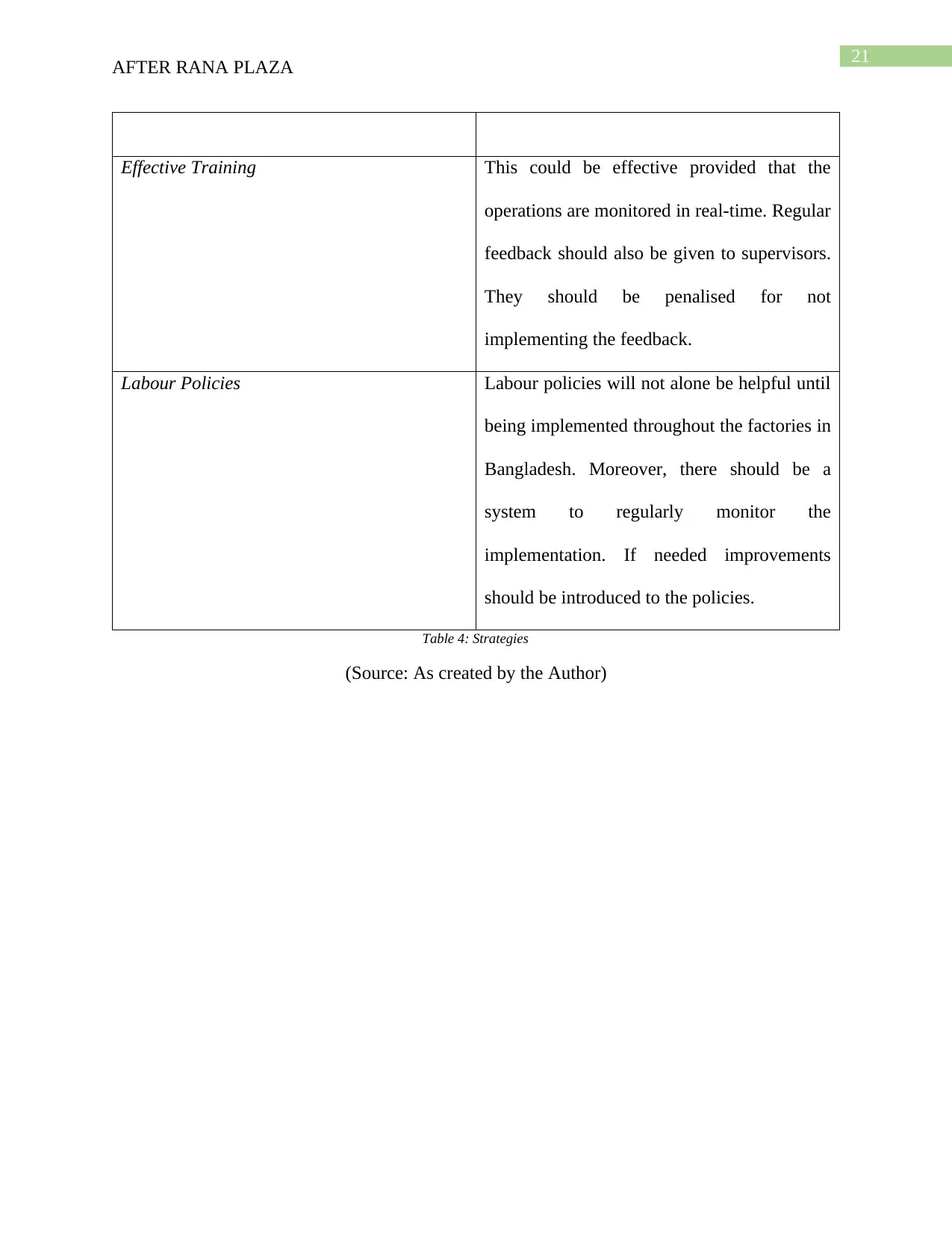
21
AFTER RANA PLAZA
Effective Training This could be effective provided that the
operations are monitored in real-time. Regular
feedback should also be given to supervisors.
They should be penalised for not
implementing the feedback.
Labour Policies Labour policies will not alone be helpful until
being implemented throughout the factories in
Bangladesh. Moreover, there should be a
system to regularly monitor the
implementation. If needed improvements
should be introduced to the policies.
Table 4: Strategies
(Source: As created by the Author)
AFTER RANA PLAZA
Effective Training This could be effective provided that the
operations are monitored in real-time. Regular
feedback should also be given to supervisors.
They should be penalised for not
implementing the feedback.
Labour Policies Labour policies will not alone be helpful until
being implemented throughout the factories in
Bangladesh. Moreover, there should be a
system to regularly monitor the
implementation. If needed improvements
should be introduced to the policies.
Table 4: Strategies
(Source: As created by the Author)
Secure Best Marks with AI Grader
Need help grading? Try our AI Grader for instant feedback on your assignments.
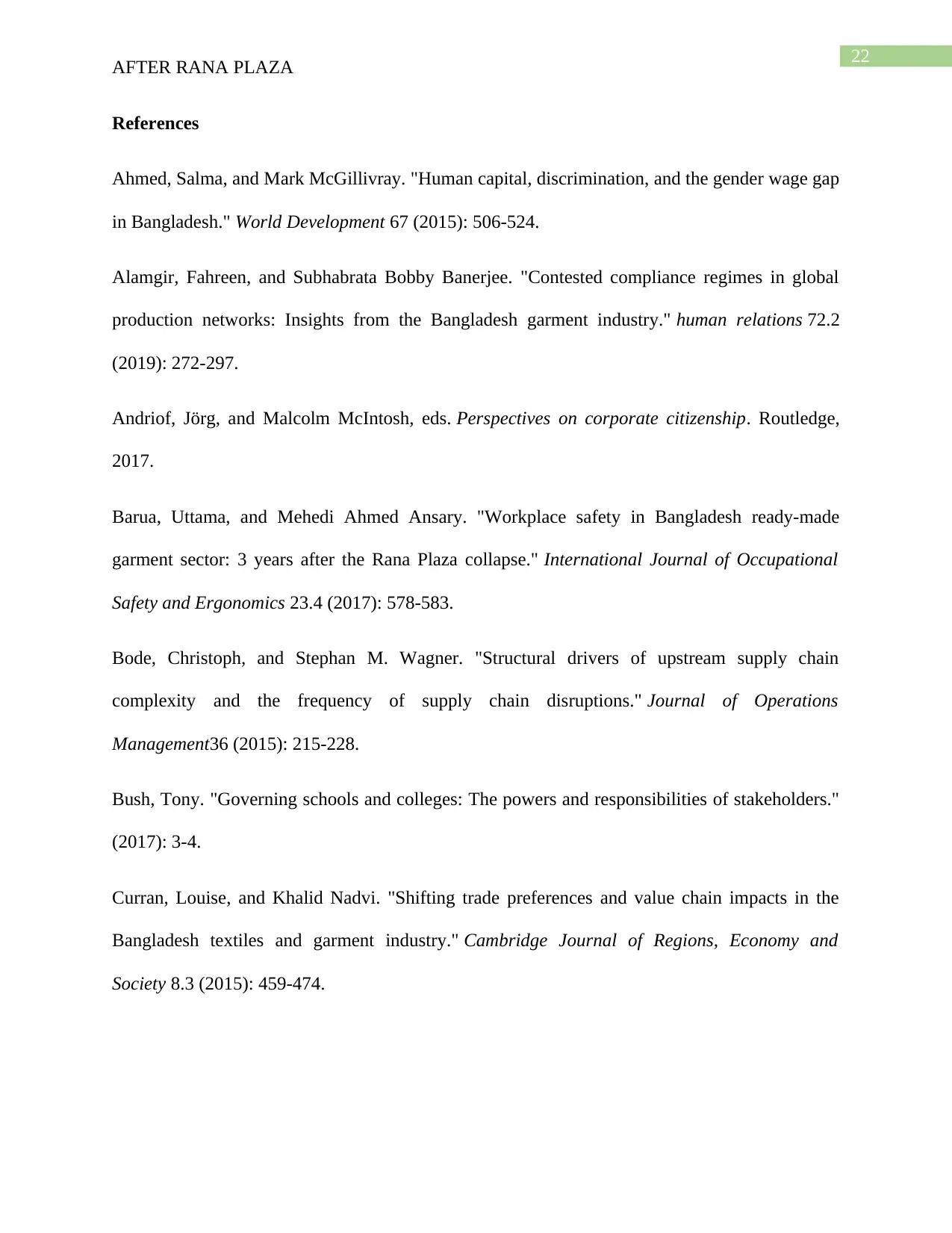
22
AFTER RANA PLAZA
References
Ahmed, Salma, and Mark McGillivray. "Human capital, discrimination, and the gender wage gap
in Bangladesh." World Development 67 (2015): 506-524.
Alamgir, Fahreen, and Subhabrata Bobby Banerjee. "Contested compliance regimes in global
production networks: Insights from the Bangladesh garment industry." human relations 72.2
(2019): 272-297.
Andriof, Jörg, and Malcolm McIntosh, eds. Perspectives on corporate citizenship. Routledge,
2017.
Barua, Uttama, and Mehedi Ahmed Ansary. "Workplace safety in Bangladesh ready-made
garment sector: 3 years after the Rana Plaza collapse." International Journal of Occupational
Safety and Ergonomics 23.4 (2017): 578-583.
Bode, Christoph, and Stephan M. Wagner. "Structural drivers of upstream supply chain
complexity and the frequency of supply chain disruptions." Journal of Operations
Management36 (2015): 215-228.
Bush, Tony. "Governing schools and colleges: The powers and responsibilities of stakeholders."
(2017): 3-4.
Curran, Louise, and Khalid Nadvi. "Shifting trade preferences and value chain impacts in the
Bangladesh textiles and garment industry." Cambridge Journal of Regions, Economy and
Society 8.3 (2015): 459-474.
AFTER RANA PLAZA
References
Ahmed, Salma, and Mark McGillivray. "Human capital, discrimination, and the gender wage gap
in Bangladesh." World Development 67 (2015): 506-524.
Alamgir, Fahreen, and Subhabrata Bobby Banerjee. "Contested compliance regimes in global
production networks: Insights from the Bangladesh garment industry." human relations 72.2
(2019): 272-297.
Andriof, Jörg, and Malcolm McIntosh, eds. Perspectives on corporate citizenship. Routledge,
2017.
Barua, Uttama, and Mehedi Ahmed Ansary. "Workplace safety in Bangladesh ready-made
garment sector: 3 years after the Rana Plaza collapse." International Journal of Occupational
Safety and Ergonomics 23.4 (2017): 578-583.
Bode, Christoph, and Stephan M. Wagner. "Structural drivers of upstream supply chain
complexity and the frequency of supply chain disruptions." Journal of Operations
Management36 (2015): 215-228.
Bush, Tony. "Governing schools and colleges: The powers and responsibilities of stakeholders."
(2017): 3-4.
Curran, Louise, and Khalid Nadvi. "Shifting trade preferences and value chain impacts in the
Bangladesh textiles and garment industry." Cambridge Journal of Regions, Economy and
Society 8.3 (2015): 459-474.
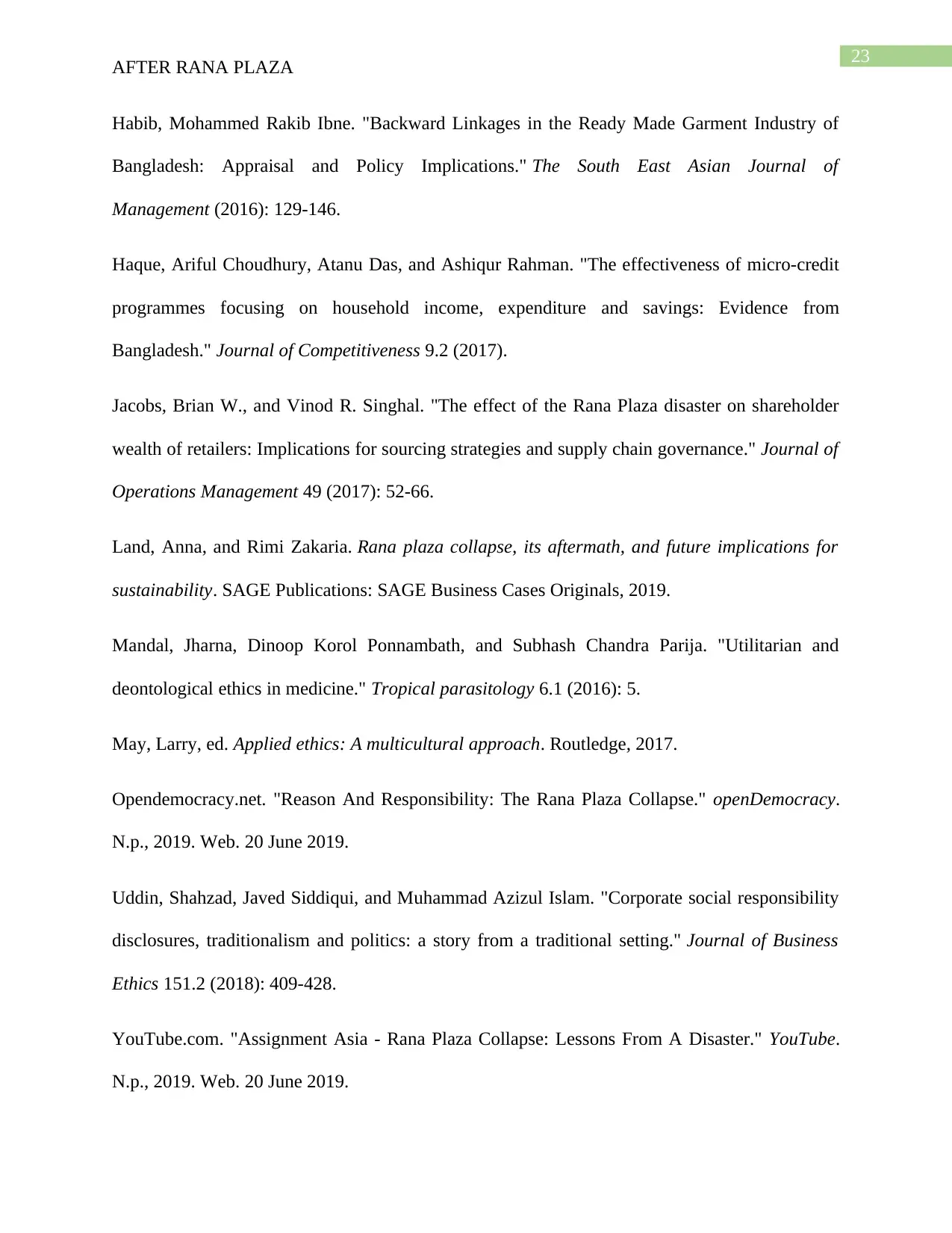
23
AFTER RANA PLAZA
Habib, Mohammed Rakib Ibne. "Backward Linkages in the Ready Made Garment Industry of
Bangladesh: Appraisal and Policy Implications." The South East Asian Journal of
Management (2016): 129-146.
Haque, Ariful Choudhury, Atanu Das, and Ashiqur Rahman. "The effectiveness of micro-credit
programmes focusing on household income, expenditure and savings: Evidence from
Bangladesh." Journal of Competitiveness 9.2 (2017).
Jacobs, Brian W., and Vinod R. Singhal. "The effect of the Rana Plaza disaster on shareholder
wealth of retailers: Implications for sourcing strategies and supply chain governance." Journal of
Operations Management 49 (2017): 52-66.
Land, Anna, and Rimi Zakaria. Rana plaza collapse, its aftermath, and future implications for
sustainability. SAGE Publications: SAGE Business Cases Originals, 2019.
Mandal, Jharna, Dinoop Korol Ponnambath, and Subhash Chandra Parija. "Utilitarian and
deontological ethics in medicine." Tropical parasitology 6.1 (2016): 5.
May, Larry, ed. Applied ethics: A multicultural approach. Routledge, 2017.
Opendemocracy.net. "Reason And Responsibility: The Rana Plaza Collapse." openDemocracy.
N.p., 2019. Web. 20 June 2019.
Uddin, Shahzad, Javed Siddiqui, and Muhammad Azizul Islam. "Corporate social responsibility
disclosures, traditionalism and politics: a story from a traditional setting." Journal of Business
Ethics 151.2 (2018): 409-428.
YouTube.com. "Assignment Asia - Rana Plaza Collapse: Lessons From A Disaster." YouTube.
N.p., 2019. Web. 20 June 2019.
AFTER RANA PLAZA
Habib, Mohammed Rakib Ibne. "Backward Linkages in the Ready Made Garment Industry of
Bangladesh: Appraisal and Policy Implications." The South East Asian Journal of
Management (2016): 129-146.
Haque, Ariful Choudhury, Atanu Das, and Ashiqur Rahman. "The effectiveness of micro-credit
programmes focusing on household income, expenditure and savings: Evidence from
Bangladesh." Journal of Competitiveness 9.2 (2017).
Jacobs, Brian W., and Vinod R. Singhal. "The effect of the Rana Plaza disaster on shareholder
wealth of retailers: Implications for sourcing strategies and supply chain governance." Journal of
Operations Management 49 (2017): 52-66.
Land, Anna, and Rimi Zakaria. Rana plaza collapse, its aftermath, and future implications for
sustainability. SAGE Publications: SAGE Business Cases Originals, 2019.
Mandal, Jharna, Dinoop Korol Ponnambath, and Subhash Chandra Parija. "Utilitarian and
deontological ethics in medicine." Tropical parasitology 6.1 (2016): 5.
May, Larry, ed. Applied ethics: A multicultural approach. Routledge, 2017.
Opendemocracy.net. "Reason And Responsibility: The Rana Plaza Collapse." openDemocracy.
N.p., 2019. Web. 20 June 2019.
Uddin, Shahzad, Javed Siddiqui, and Muhammad Azizul Islam. "Corporate social responsibility
disclosures, traditionalism and politics: a story from a traditional setting." Journal of Business
Ethics 151.2 (2018): 409-428.
YouTube.com. "Assignment Asia - Rana Plaza Collapse: Lessons From A Disaster." YouTube.
N.p., 2019. Web. 20 June 2019.
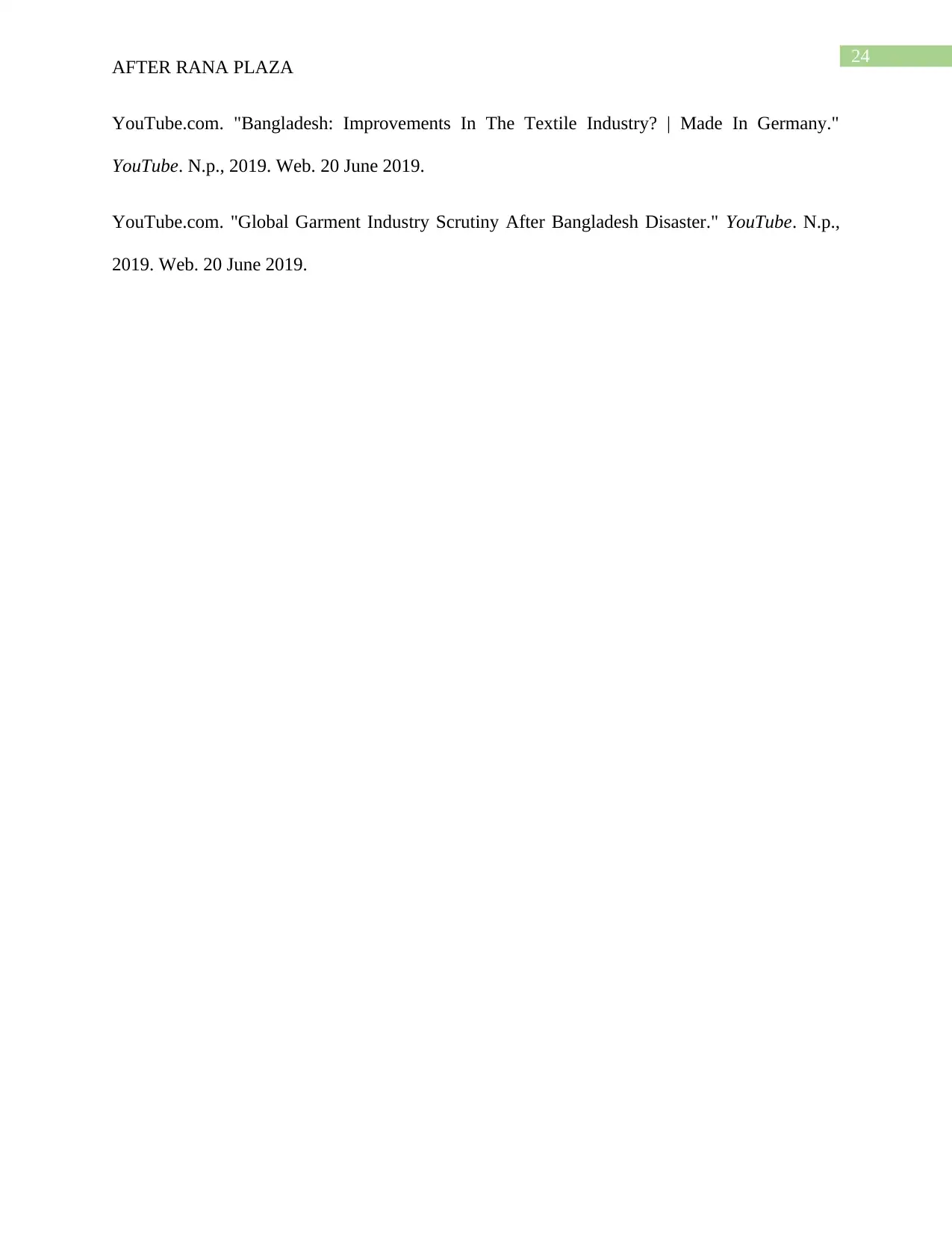
24
AFTER RANA PLAZA
YouTube.com. "Bangladesh: Improvements In The Textile Industry? | Made In Germany."
YouTube. N.p., 2019. Web. 20 June 2019.
YouTube.com. "Global Garment Industry Scrutiny After Bangladesh Disaster." YouTube. N.p.,
2019. Web. 20 June 2019.
AFTER RANA PLAZA
YouTube.com. "Bangladesh: Improvements In The Textile Industry? | Made In Germany."
YouTube. N.p., 2019. Web. 20 June 2019.
YouTube.com. "Global Garment Industry Scrutiny After Bangladesh Disaster." YouTube. N.p.,
2019. Web. 20 June 2019.
1 out of 25
Related Documents
Your All-in-One AI-Powered Toolkit for Academic Success.
+13062052269
info@desklib.com
Available 24*7 on WhatsApp / Email
![[object Object]](/_next/static/media/star-bottom.7253800d.svg)
Unlock your academic potential
© 2024 | Zucol Services PVT LTD | All rights reserved.
